new posts in all blogs
Viewing Blog: Tara Lazar, Most Recent at Top
Results 26 - 50 of 638

"A little nonsense now and then is relished by the wisest men." -Roald Dahl
Statistics for Tara Lazar
Number of Readers that added this blog to their MyJacketFlap: 18
by Ammi-Joan Paquette
Let me say one thing straight out: My picture book, GHOST IN THE HOUSE, is very close to my heart. Of my published picture books, it’s the one that’s gotten the most visibility so far, including a fabulous review in the New York Times, several “Best of the Year” roundups, and a pickup by the Scholastic Clubs and Fairs. Needless to say, these small joys absolutely thrilled me.

But also? I have to be honest: They surprised me a little. Those of you who have heard me speak about GHOST IN THE HOUSE will have heard how it came about: Following the rejection of another Halloween manuscript, an editor asked if I “had any other spooky rhyming picture books.” At that moment, I did not. Several weeks, much brainstorming, and a torrent of writing later, I did.
Don’t get me wrong. I worked hard on GHOST IN THE HOUSE. But compared to many of my picture book texts, over which I toiled ad infinitum, this text came relatively easy. The end result also felt, well, simple. It was a sweet, zippy rhyming story. Short and to the point. Fun characters, neat twist. But when lined up against my other laboriously crafted stories—and, in particular, the one it had originally supplanted—it felt uncomfortably ordinary.
Still, someone wanted to publish my picture book! Joy!
In the months following publication, I gained more respect for my modest little manuscript. But it took one final thing to bring me fully around. And that was this: One day I received an email from my editor at Candlewick, asking what I would think about writing a companion book. It might, she suggested, be called ELF IN THE HOUSE.
Well! Ask no further—I was on it. GHOST was just a simple, puny little story, right? I could crank out another one of those in a flash. No worries!
Instead? I hit the blank page. Hard.
Frustrated at my false starts, I sat down and listed the elements that made up GHOST IN THE HOUSE, so I could attempt to replicate them (in a perfectly organic, all-new-and-fresh way, with a Christmas spin) in the sequel. Here’s what I needed:
- recognizable creatures
- a reason for the creatures to accumulate
- tension—what’s keeping the reader turning the pages?
- perfect fit to the rhyming scheme
- surprising twist
- satisfying, feel-good ending
Let’s just say (if that list wasn’t clear enough), that this exercise made me look at GHOST in a whole new light. Short? Yes. Simple-easy-basic-ordinary? Not so much.
Astute readers will likely have seen this coming, but ELF IN THE HOUSE did not come in a flash. More than once I doubted if I could pull it off at all. It took writing, and rewriting, and re-rewriting. Forget inspiration: This was deliberate, backbreaking effort: Lists and brainstorming and trial-and-error and throw-it-all-out-and-start-over. Time after time after time. I’d almost have it… but not quite. This angle might work… only not.
It did not come easy. Not even close.
But finally, in the end, it did come. And great was my delight when my editor received my final manuscript, and made a publication offer. (Woohoo!)
Once ELF IN THE HOUSE is published, I imagine most readers won’t see much difference in tone between the two stories. From the outside, it’s likely that they’ll both appear effortless and breezy. But what this experience crystalized for me was that stories can be born in all sorts of ways. Some arrive on the magical wings of inspiration, landing lightly on your shoulder and seeping onto the screen with the greatest of ease. Others bare their bloody fangs and force you to wrestle them into submission.
One method, one origin, one final story is not necessarily greater than any other. We are authors: we take what we can get, and we make it our own. It’s the making—however long or short, easy or gut-hard—that brings the magic.


Ammi-Joan Paquette is an author and a literary agent with Erin Murphy Literary Agency. She’s a mother, friend, reader, traveler, food-lover, chocolate connoisseur. She is not especially tidy, a fan of mushy vegetables, or good at coming up with spur-of-the-moment self-portraits.
Learn more about Joan and her books at ajpaquette.com and follow her on Twitter @JoanPaq.


 by Diana Murray
by Diana Murray
Picture books are as varied as the potions in a witch’s cupboard. Some are spicy and bubbly, while others are mellow and sweet. So which kinds of stories are editors and agents clamoring for? Well, their tastes are just as varied. But one thing that seems to be on everyone’s wish list is this: character-driven stories. A few examples include FANCY NANCY by Jane O’Connor, LLAMA LLAMA RED PAJAMA by Anna Dewdney, PINKALICIOUS by Elizabeth Kann, RUSSELL THE SHEEP by Rob Scotton, SKIPPYJON JONES by Judy Schachner, PETE THE CAT by Eric Litwin, LADYBUG GIRL by David Soman and Jacky Davis, MAX AND RUBY by Rosemary Wells, and SCAREDY SQUIRREL by Mélanie Watt. As you can see, character-driven books have great series potential and overall marketing potential. When readers fall in love with a character, they want to read more about him/her, and it’s fun to visualize what other sorts of situations the character may get into.
This doesn’t mean that character-driven stories are the only kinds that sell or do well in the marketplace. Nor does it mean that writers should focus primarily on pleasing editors or following trends. The best writing comes from the heart! But with that in mind, if you want to explore the possibilities of a character-driven story, here is one quick and easy recipe for brewing up a strong concept. Two ingredients are all you need!
- Personality Trait
- Conflicting Goal
I recommend you start off with a list of your own personality traits. This will make it easy for you to feel an emotional connection with (and understanding of) the trait.
My list might look something like this:
- introverted
- joker
- nerdy
- perfectionist
- quiet
- creative
- analytical
- messy
- quirky
- worrier

Pick one trait (or several, if you’re feeling bold!). Next, choose a goal. Not just any goal, but specifically a goal that is in opposition to the trait you selected. When I wrote GRIMELDA, THE VERY MESSY WITCH, I chose the trait of being “messy” and made the goal “to find an item the character desperately wants/needs.” Or let’s say, for example, I choose “quiet”, then perhaps the goal would be to sing on stage, or speak out against something, or win an international yodeling contest. Sprinkle the goal in with your trait and–POOF! Instant conflict. And the conflict is intrinsically related to the essence of the main character. Adding conflict to a story is one way of encouraging readers to keep turning the pages. They’ll want to find out what happens next! Now, how will your character attempt to reach that goal or face that problem in his/her own unique way?
Feel that story bubbling to life? Now all you have to do is write (and revise, and revise) the rest. Of course, that’s the hard part. But a little inspiration magic can go a long way!

Diana Murray is the author of several forthcoming picture books including, CITY SHAPES (Little, Brown, Spring 2016), NED THE KNITTING PIRATE: A SALTY YARN (Roaring Brook Press, Winter 2016), and GRIMELDA, THE VERY MESSY WITCH, plus a sequel (Katherine Tegen Books/HarperCollins, Summer 2016, 2017). Diana is the recipient of two SCBWI Magazine Merit Awards (2013 and 2014) and an Honor (2013) for poetry. She also won the 2010 SCBWI Barbara Karlin Work-In-Progress Grant for a picture book text. Diana is represented by Brianne Johnson at Writers House. She was raised in New York City and currently lives in a nearby suburb with her husband, two very messy children, and a goldfish named Pickle. Diana’s character GRIMELDA was brewed up during the first official PiBoIdMo, back in 2009! You can read more about that experience here.
For more information and news, you can visit DianaMurray.com or follow Diana on twitter: @DianaMWrites.

Diana is giving away a picture book critique!
This prize will be given away at the conclusion of PiBoIdMo. You are eligible for this prize if:
- You have registered for PiBoIdMo.
- You have commented ONCE ONLY on today’s post.
- You have completed the PiBoIdMo challenge. (You will have to sign the PiBoIdMo Pledge at the end of the event.)
Good luck, everyone!



By:
Tara Lazar,
on 11/21/2014
Blog:
Tara Lazar
(
Login to Add to MyJacketFlap)
JacketFlap tags:
Caitlin B. Alexander,
Nacho the Party Puppy,
The Critter Club,
What This Story Needs is a Pig in a Wig,
Picture Books,
Emma Virjan,
Marsha Riti,
Girllustrators,
PiBoIdMo 2014,
Add a tag
Today I invited The Girllustrators, Austin-based kidlit artists, to guest blog for PiBoIdMo, so you’re getting THREE inspirational essays—by Emma Virján, Caitlin B. Alexander and Marsha Riti—for the price of one. (And they’re all FREE, LOL.) I recommend following these talented ladies on Twitter @Girllustrators.

Up first: Emma Virján!
WHAT THIS STORY NEEDS IS A PIG IN A WIG started with this doodle of pig snouts.
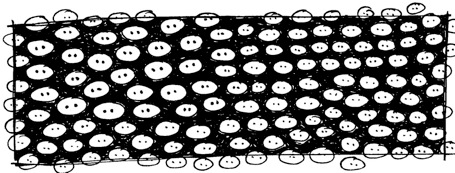
Sketches of pigs started to fill my notebooks.

After many drawings, I determined pig needed a name. I named her Pig.
It was also determined that she needed a wig.

I drew Pig wearing many different wigs.

I loved Pig in all of her wigs (still do) but this one became my favorite.

The story of Pig and her wig started to take shape. Work began on a manuscript.

The words “on a boat” kept cropping up and I started drawing images of Pig near a boat.
Sometimes I only drew the boat. The boat always had a pig snout on the bow.
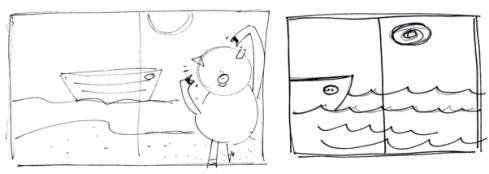
The first of many thumbnails were created.
So began the real work of the images and words becoming a picture book.
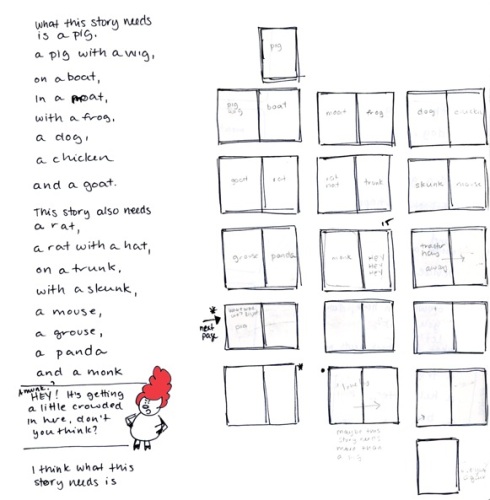
Revisions happened. Drawings were scrapped and new ones were drawn. More revisions happened and eventually What This Story Needs Is A Pig In A Wig was finalized.


It’s amazing to think that a black and white doodle of pig snouts, drawn while on the phone with a client, became the inspiration for a character and a story.
And the endpapers.


Emma J Virján was born under an Aries moon on a Wednesday, her dad’s bowling night. This explains her attraction to hardwood floors. She likes to draw, work in her garden and often lets her dog sleep on the couch. She makes her home in Austin, Texas where she spends her days as an illustrator and graphic designer.
She is the author-illustrator of Nacho the Party Puppy, Random House, 2008, and the forthcoming What This Story Needs Is A Pig In a Wig, HarperCollins, May 12, 2015.
You can visit Emma Virján at Emmavirjan.com and follow her illustrative moods on Twitter @EmmaVirjan.
____________________________________________________________________________

Next is Caitlin B. Alexander!
Being an illustrator, my concept for a story grows in tandem with my visual ideas. I look at children’s books that I admire, both old and new, and take note of what draws me to them. Is it the overarching message? The color palette? The scenery? What medium did they use for the art, and what kind of characters did they use? The art or writing may not resemble my work, but something about it can still inspire me. I have a massive collection of books that I turn to frequently.

I am somewhat of an overly-organized person, so I make all sorts of bubble charts and graphs, with ideas sprouting into other ideas. Some of these are just images I would love to incorporate into a story, like a sailboat, and others are larger concepts. Eventually, with a lot of scribbling, listing, doodling, highlighting, and sample-writing, I come up with a rough idea or two that can be explored further. It reminds me of a slab of clay that has barely taken shape, but has a lot of potential.


I wish I could say that I know what perfect and repeating formula works for getting a book published, but there are probably few people who do. The rest of us just create things that we love, and keep learning, making mistakes and trying new things. If we’re lucky, we’ve hit the right combination, and someone else has fallen in love with the idea as much as we have.




Caitlin B. Alexander is an illustrator based in Austin, Texas with a particular love for dry-brush gouache painting. Both her life and work are heavily influenced by the aesthetics of the 1940′s, ’50s and ’60s. She fancies herself a collector of memories as much as a collector of things, andenjoys bringing this sense of nostalgia to her audience.
Clients include: Spider Magazine, Ladybug Magazine (Cricket Media), Geneologie, Texas Board of Tourism, Dallas Child Magazine, Bearded Lady Screen Prints, Austin Society of Children’s Book Writers and Illustrators, PERC Coffee, The Kloud Agency, What’s Up Annapolis? Magazine
Visit Caitlin’s website at cbaillustration.com, follow her Tumblr at cbaillustration.tumblr.com and Tweet with her @cbaillustration.
____________________________________________________________________________

And now…Marsha Riti!
Because I consider myself an illustrator first and foremost, the way I approach storytelling is a bit different than a writer. My inspiration comes from sketching and playing around with materials.
I’m currently working on a dreamy story about a girl, a rabbit, and the moon. This story came about from playing around with loose watercolor techniques and other materials.

Then I started playing with character sketches.

I love to thumbnail out ideas. Tara Lazar has a great thumbnail guide on her website and so does Debbie Ohi.

Here’s a small sample of a double-page layout.

And here’s a finished spread.
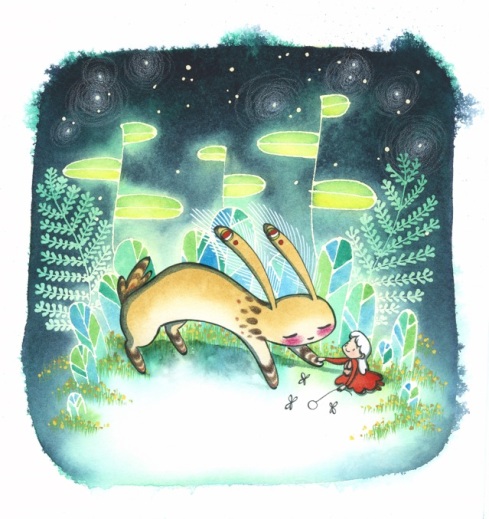
This process naturally lends itself to wordless storytelling, but I don’t want to limit myself. If the story needs words, then I’ll supply them. If it does not, then so be it.
One other place I find inspiration is this quote below from a Blake poem titled “Night.”
“The moon like a flower,
In heaven’s high bower,
With silent delight!
Sits and smiles on the night.” ~ William Blake
My husband and best friend Adam happened across it while reading “Songs of Innocence.” Adam is another source of inspiration. We have wonderful conversations about life and philosophy that are always giving me new ideas.

Marsha Riti is a children’s book illustrator from Austin, Texas. She has been a member of SCBWI for a number of years, and is also a co-founder and member of a female illustrator collective called the Girllustrators. She is currently illustrating a chapter book series for Simon & Schuster, The Critter Club, and is represented by Teresa Kietlinksi of Prospect Agency. And she’s got a wicked sense of humor.
Tara featured Marsha in a “Portrait of an Aspiring Illustrator” in March 2009.
View Marsha’s artwork and latest projects at marshariti.com and follow along on Twitter @marshariti.

Emma is giving away a NACHO THE PARTY PUPPY book and tee!
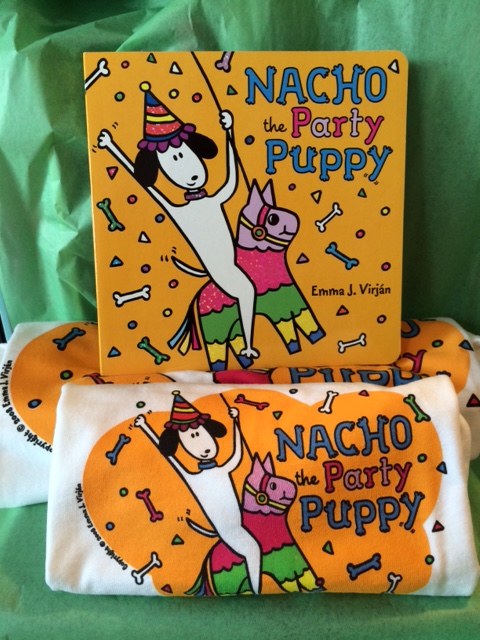
And Marsha is donating two books from THE CRITTER CLUB!


These prizes will be given away at the conclusion of PiBoIdMo. You are eligible for these prizes if:
- You have registered for PiBoIdMo.
- You have commented ONCE ONLY on today’s post.
- You have completed the PiBoIdMo challenge. (You will have to sign the PiBoIdMo Pledge at the end of the event.)
Good luck, everyone!


by Henry Herz
Everything I know about writing picture books, I learned from animals.
Animals make great picture book characters. Just ask the Very Hungry Caterpillar. And animals offer authors and illustrators nine B’s of inspiration for creating PBs:
Be a sponge.
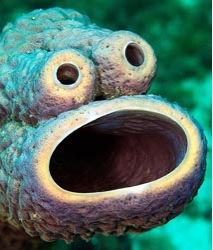
Soak up everything around you. View, listen, sniff, taste, and feel. Watch people (in public, not with a telescope from your house), read books (especially picture books), and watch TV and movies. Take notes. Even the most mundane situations can unexpectedly feed your muse.
Be a sharktopus.
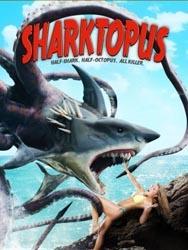
OK, that’s not a real animal, but I’m making a point here, people. Combine elements into unlikely (and therefore hilarious) pairs, as in Doreen Cronin’s Click Clack Moo: Cows That Type. Practice riffing on the things you soak up. I did a classroom reading where this boy had a torn-up sneaker. I thought, picture book title: The Boy With Exploding Sneakers. Let your creativity run free.
Be a honey badger.

Have no fear. Don’t be scared to put words to paper. Don’t flee from constructive criticism. Don’t be afraid of rejection. They all line the path to traditional publication. Honey badger don’t care, and neither should you! Get outside your comfort zone.
Be a dung beetle.

Be tenacious, even on crappy days. Becoming published isn’t easy. But it won’t happen if you stop trying. The journey of a thousand miles begins with a one step. Revise, revise, revise. But remember that perfect can be the enemy of good enough. At some point, you need to submit!
Be an armadillo.

You need to be thick-skinned and learn to roll with the punches. Understand that a publisher’s or agent’s rejection isn’t personal, but it is highly subjective. Many great works of literature were rejected repeatedly before being published, so you’re in good company.
Be an ant.
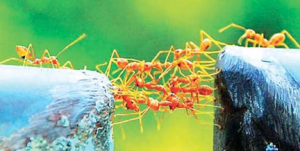
No man is an island, and no ant is a bridge. Teamwork is your best friend. Take advantage of critique groups to hone your craft. Join the Society of Children’s Book Writers and Illustrators (SCBWI) to develop a support network. Leverage social media to connect with fellow writers. You’re not alone.
Be a hagfish.
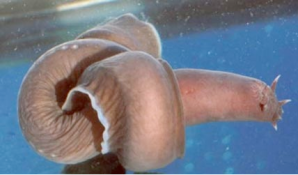
Be flexible enough to incorporate helpful feedback. But feel free to ignore feedback that doesn’t resonate with your gut. Follow the rules, but recognize that they can be broken when the result is a success. Drew Daywalt’s The Day the Crayons Quit is a picture book with over 1,000 words and inanimate characters. But it’s also a New York Times bestseller.
Be a peacock spider.
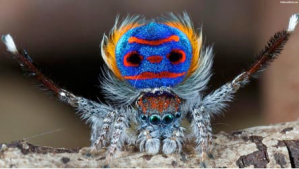
Male peacock spiders don’t just have stunning colors. They have a delightfully entertaining mating dance (think MC Hammer’s “Can’t Touch This”). They show the ladies some enthusiasm! They wear their passion on their, er, sleeves. Writing is also an act of passion. Write about what you love. Have fun writing. Write the story that is inside you, trying to get out. But hopefully not like a chestburster from Alien, or Ian Ziering in the final scene of Sharknado.
Be a cat.

Cats are lucky. They always land on their feet, and have nine lives.
There’s an expression, “luck favors the prepared.” Working at the other eight B’s is the best way to earn some luck. Good luck to you!

 Henry Herz has masters degrees in engineering and political science, neither of which help him write children’s books. He enjoys moderating sci-fi/fantasy literature panels at conventions, eating Boston Creme Pie, and writing children’s books with his sons Josh and Harrison. Their indie-published Nimpentoad was featured in Young Entrepreneur, Wired GeekDad, and CNN. Their picture book, Monster Goose Nursery Rhymes, will be published by Pelican in January 2015. Henry edited the YA dark fantasy anthology, Beyond the Pale, with stories from Peter S. Beagle, Heather Brewer, Jim Butcher, Rachel Caine, Kami Garcia, Nancy Holder, Jane Yolen and others. He interviews KidLit authors and illustrators at www.henryherz.com.
Henry Herz has masters degrees in engineering and political science, neither of which help him write children’s books. He enjoys moderating sci-fi/fantasy literature panels at conventions, eating Boston Creme Pie, and writing children’s books with his sons Josh and Harrison. Their indie-published Nimpentoad was featured in Young Entrepreneur, Wired GeekDad, and CNN. Their picture book, Monster Goose Nursery Rhymes, will be published by Pelican in January 2015. Henry edited the YA dark fantasy anthology, Beyond the Pale, with stories from Peter S. Beagle, Heather Brewer, Jim Butcher, Rachel Caine, Kami Garcia, Nancy Holder, Jane Yolen and others. He interviews KidLit authors and illustrators at www.henryherz.com.

Henry is offering two picture book critiques to two PiBoIdMo winners!
These prizes will be given away at the conclusion of PiBoIdMo. You are eligible for these prizes if:
- You have registered for PiBoIdMo.
- You have commented ONCE ONLY on today’s post.
- You have completed the PiBoIdMo challenge. (You will have to sign the PiBoIdMo Pledge at the end of the event.)
Good luck, everyone!


 by Kelly Light
by Kelly Light
“I want to be The Hardest Working WO-Man in Show Business”
But I’m tired. Are you?
It’s been an insane few months in my life. My book, Louise Loves Art, came out September 9th! Then I went on a 27-day book tour.
When I sit down to work and I have A LOT of work…sometimes, I got ‘nuthin.
Sometimes we feel like we just can’t go on.
We can’t do no more.
But you can. You can get back up. Like James.
You can find it in yourself. You have come this far.
You can still dance and spin.
You’ve got more ideas inside of you, dig. Dig deep.
Throw off that cape! Pull yourself up.
Let’s channel a little James this year.
Watch this:
James Brown.
The hardest working Man in show business.
Even he just has to fall on his knees and ask… Please.!?!?
Please, please, please, please.
Let’s grab the mic, Wacom pen, pencil or hairbrush … and sing with……PAIN.
(back up singers in parenthesis) (PiBoIdMo peeps – that’s you)
Spoken like James:
This year I gotta dig a little deeper.
Ya see ‘cause I am tired.
I’ve been working so hard.
(So hard. )
So hard.
(So hard.)
Start singing:
30 ideas in 30 days.
(Who came up with this idea?)
11 more to go, you’re in a daze
(I need a shot of tequila)
Pencil in hand, butt in chair.
(I gotta find a new idea)
Ideas, I can’t find you anywhere
(need to get my head in gear)
Yeah, oh yeah, ideas, I need you so..
(Please, please ideas don’t go)
Please, please, please, please….
(Please, please don’t go)
Please, please, please….
(Please, please ideas don’t go)
Can you hep me?
Somebody hep me!
Please, please, please, please….
(Please, please don’t go)
Please, please, please….
(Please, please ideas don’t go)
Imagination is all gone
(all dried up, ideas are gone)
Why did you leave and do me wrong?
(you are fried, you can’t hold on)
Please, please, please, please….
(Please, please don’t go)
Please, please, please….
(Please, please ideas don’t go)
I wrote so many ideas down
(So you wrote some good ideas)
I used some adjectives and some nouns
(these sound like bad ideas)
Doesn’t matter, I got 30 ideas out
(ideas on the page it’s a start)
Makes me wanna scream and shout!
(Keep on going, you’ve got heart!)
I’ll come back to these ideas one day
(Don’t leave them up on a shelf)
Soon You’ll see me signing at BEA!
(don’t get ahead of yourself, do 12 X 12)
Please, please, please, please….
(Please, please don’t go)
Please, please, please….
(Please, please ideas don’t go)
Danny! I can’t do no more…
WAIT! C’mon….
Now JUMP BACK! You’re super bad! You gotta kiss yourself!
Listen to this:

Kelly Light is working hard out on the road with LOUISE LOVES ART while working on the second Louise book and the first Louise reader. Look for those next year from Balzer and Bray. Also out next year is JUST ADD GLITTER by Angela DiTerlizzi from Beach Lane Books. She’s got soul. She’s tired and she’s super bad.


You can win a signed LOUISE LOVES ART book and a “Holiday Louise” print by Kelly!
These prizes will be given away at the conclusion of PiBoIdMo. You are eligible for these prizes if:
- You have registered for PiBoIdMo.
- You have commented ONCE ONLY on today’s post.
- You have completed the PiBoIdMo challenge. (You will have to sign the PiBoIdMo Pledge at the end of the event.)
Good luck, everyone!


 by Dev Petty
by Dev Petty
I know, I know…You’ve probably read or been told you should write every day. Twenty minutes? Thirty minutes? Some number of minutes that gets you off your behind and typing away.
But I’m here to suggest a different approach, something especially useful for picture book writers.
STOP Writing.

Yes, you heard it here first. Stop. At least for a while.
Work with me here…
When I was first writing picture books and I found a story idea, I’d race home and get to writing it. Words streamed off my finger tips into my story, clickety-clack, clickety-clack and BOOM! I’d be done and I’d congratulate myself for finishing. Then I’d edit and revise and tinker and make little changes. I wrote a lot of stories this way, but they were often a bit one note. They were linear, a super straight shot at my story idea. Moving so fast from an idea to writing, I got mired in language and word choices, small stuff, instead of thinking about the idea itself. It’s one of those forest for the trees kinda things.
Somewhere along the way, I put the brakes on that process. What did I do? I started thinking.
Here’s what I’ve found. When I take some time, in some cases LOTS of time, to think about my idea and how to get that idea onto the page, I come up with a richer, more original story. I lie on my deck, I think in the shower, I think on a walk, I think on a rock, I think as I’m going to and coming out of sleep. Sometimes, if it’s a really juicy idea, I think for MONTHS about how that idea could turn into a story. Fair warning, thinking is hard. Our brains are filled with lunch making and appointments and things to do- it takes time to learn to think.

So, while I’m lying on the deck “writing” (Imagine my husband making an air quote gesture here), what am I thinking about? Well, I think about structure and about voice. I try my story in my head in different ways: Traditional, present tense, past tense, third person, sparse, only in dialogue, repetitive, wordless. When I’ve done this long enough something really strange happens. I start to hear it, I start to hear my story. Then, and only then, do I write down the words.
I also try to think about my story from many angles, to turn it around in my head. Can my idea be expressed as a metaphor or in a way that’s deeper? Is a story about a kid with head lice more interesting if it’s about a monkey with fleas? These are the deep questions I ask…”Monkey or no monkey?” Monkeys aside, a wonderful bi-product of thinking instead of writing is that you find new ideas. Ideas breed ideas, so it’s like you’re making tiny little baby stories while you’re bringing the first one into the world.
Finally, before I ever write a word, I force myself to ask myself this most basic question. WHAT IS THIS STORY ABOUT? (Hint: the answer does not have your main character’s name in it) If I can’t answer that, I’m not ready to write the story. Period.
When I finally do write words, it goes pretty fast and requires less tinkering, it comes out of the oven a little more baked. Still, in those first few moments of writing the story I’ve formed in my head, I will try the opening in a bunch of different ways to see what sticks. That opening forms the framework for the whole book and I’m always prepared to write the opening, read it back, throw it away and try again if it isn’t right before continuing.
It’s a good bet this method isn’t for everyone, but for me it has fundamentally changed my experience of writing picture books. My stories are now more ME. They have MY voice. They come out as I imagined. Also, I get to spend a lot of time in the sun just thinking. About monkeys.

Dev Petty’s debut picture book, I Don’t Want to be a Frog (Random House/Doubleday) will be released on February 24th. Told in hilarious dialogue, this book is about a frog who wants to be anything but a slimy, wet frog. Before writing children’s books, Dev worked as a senior visual effects artist in film on The Matrix films and dozens of others. She lives in Albany with her husband, two daughters and critters. Connect with her at www.devpetty.com.

Dev is giving away a picture book critique!
This prize will be given away at the conclusion of PiBoIdMo. You are eligible for this prize if:
- You have registered for PiBoIdMo.
- You have commented ONCE ONLY on today’s post.
- You have completed the PiBoIdMo challenge. (You will have to sign the PiBoIdMo Pledge at the end of the event.)
Good luck, everyone!



By:
Tara Lazar,
on 11/17/2014
Blog:
Tara Lazar
(
Login to Add to MyJacketFlap)
JacketFlap tags:
Picture Books,
Deborah Underwood,
The Quiet Book,
The Loud Book,
Part-Time Princess,
Sugar Plum Ballerina,
PiBoIdMo 2014,
Here Comes Santa Cat,
Here Comes the Easter Cat,
Add a tag
 by Deborah Underwood
by Deborah Underwood
Congratulations, PiBoIdMo-ers! You’re more than halfway home! (56.6666% home, but who’s counting?)
At this point in the game, you may be a little stuck. Believe me, I know the feeling. When I’m devoid of ideas, sometimes remembering the origins of an existing manuscript yields clues about how I might forge ahead.
So, in hopes that it might help you, let me share the genesis of Here Comes the Easter Cat, illustrated by Claudia Rueda. The book resulted from three things that happened in June of 2011:
1) I was floundering around looking for inspiration, so I wrote to a friend, the founder of an animal museum. I asked if there was a kids’ book she saw a need for, something that might be helpful to her in her work. She mentioned that a woman she knew had trouble finding suitable Easter books for her vegan book review site. I didn’t find the idea of writing an Easter book particularly compelling, so I thanked her and promptly forgot about her suggestion. (Or so I thought!)
2) A few weeks later, I had a weirdly illustrator-centric week. I had coffee with one visiting illustrator, coffee another day with two others, and lunch with a local illustrator friend.
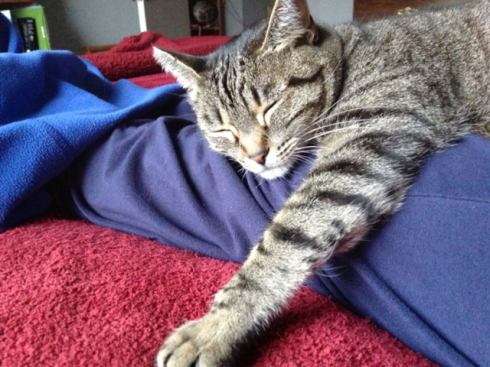
3) Several days after that, I was sitting on my bed, still trying to come up with a viable idea. My cat Bella was sprawled in front of me, so I idly doodled a cat. The cat looked grumpy. I asked why, and, to my surprise, the cat held up a sign with the Easter Bunny on it. Intrigued, I continued to ask the cat questions, and Here Comes the Easter Cat took shape.



Why did I decide to draw? I’m not sure, but I’ll bet it was because I’d just talked with all those illustrators.
And why did the Easter Bunny show up on Cat’s sign? Undoubtedly because my friend had mentioned that Easter book a few weeks earlier.
So the book idea came about because:
- I actively sought input from someone outside my usual circle.
- I took off my pajamas—horrors!—and got out into the world, and in doing so, learned more about how illustrators work.
- I gave myself the space to think (sitting on my bed, trying to be receptive) and to play (doodling).
So I was active, and I was passive. I soaked up information from others, and I experimented with something outside my area of expertise. If any of those elements hadn’t been present, I suspect there would be no Cat.


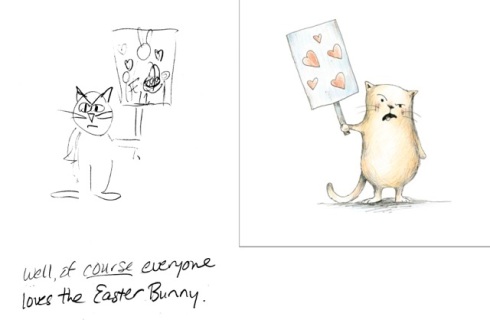
In particular, the drawing component was critical. So I encourage you to play around with doodling or sketching, even if you think you’re not an artist. Here Comes Easter Cat came out earlier this year, Here Comes Santa Cat was just released, and two more Cat books are in the queue. I’m very, very glad I did that first Cat sketch.
One more thing: when I began Easter Cat, I was not thinking of the market. I was definitely not saying, “What the world really needs is an 80-page picture book!” or “I’ll bet my editor is dying to see a stack of sketches by someone who can’t draw!”
Rather, I was having a conversation with Cat for the best of reasons: it amused me. It made me laugh. And what I loved turned out to be what my agent and my editor loved, too.
I am embarrassed to say that I need to remind myself of this over and over. It’s so easy to get caught up in questions like “What do editors want?” and “What can I sell?”
When really, the critical question is, “What do I love?”
So write with your heart. And draw! And if one of your sketches starts talking to you? You should probably pay attention. Best of luck!

Deborah Underwood grew up in Walla Walla, Washington. When she was little, she wanted to be an astronomer. Then she wanted to be a singer. Then she wanted to be a writer. Today her jobs are writing and singing. Two out of three’s not bad! (Okay, she also wanted to work in a piano factory and paste the labels on new pianos, but let’s just ignore that one.)
She’s the author of THE QUIET BOOK, THE LOUD BOOK, PART-TIME PRINCESS, the SUGAR PLUM BALLERINAS series (with Whoopi Goldberg), and, of course THE CAT books, among others.
When she’s not writing, you might find her singing in a chamber choir, playing a ukulele (very badly), walking around in Golden Gate Park, baking vegan cookies, or petting any dogs, cats, pigs, or turkeys that happen to be nearby.
You can connect with her at DeborahUnderwoodBooks.com or on Twitter @underwoodwriter.

Deborah is giving away one copy of EASTER CAT and one copy of SANTA CAT!


These prizes will be given away at the conclusion of PiBoIdMo. You are eligible for these prizes if:
- You have registered for PiBoIdMo.
- You have commented ONCE ONLY on today’s post.
- You have completed the PiBoIdMo challenge. (You will have to sign the PiBoIdMo Pledge at the end of the event.)
Good luck, everyone!


 by Shelley Moore Thomas
by Shelley Moore Thomas
Okay, so last year I did PiBoIdMo. At the same time, I was also trying to get 1,000 words a day finished on a middle grade novel. If you do the math, you can see that I’d have had 30,000 words on a novel and 30 ideas finished by the end of the month, were I to have been successful.
That would have been an AMAZING amount of writing.
But I was not successful. Not completely, anyway.
I logged about half of that amount of words on my novel—but that is still 15,000 more words than I would have had otherwise. So I felt pretty good about that.
But my picture book ideas. Ugh. I ended the month with 22 of them. Most were pretty crummy. I mean, I was trying to do the best that I could, but man, some of my ideas were really dumb/hideous/terrible/lame. What? You want an example? Okay, I’ll cut and paste some entries from my PiBoIdMo Journal, 2013:
November 3: (Came up with this one in my sleep) Baby Kangaroo Won’t Get Out of the Pouch I kind of see lots and lots of animals getting invited over to Joey’s pouch, but he is too scared to come out. Not sure what is going to get him to come out.

Really? I read that idea now and all I can think is POOR MAMA KANGAROO!! And also yuck. I think yuck.
Hungry for another?
November 13: Dream Dinos (Little dinos that live in your head and help you sleep….hahaha)
This whole idea just gives me the heebie-jeebies. And nightmares. Ick.
The list continues on in a similarly awful manner. 18 completely un-writable ideas.
Notice I said 18, not 22. That is because 4 of the ideas I recorded last November were pretty darn good. Actually, they were incredible. I am working on two of them right now, and will tackle the other two a time permits. (I wish I could tell you about them, but I can’t talk about picture book ideas when they are in progress. Ruins the magic of it.)
The truth of it is that I never would have come up with the 4 ideas that I really like if I hadn’t been willing to take a chance and just try and come up with one idea each day. (And each day, I did feel pretty satisfied with what my muse had given me. It was only upon later reading that I thought BLECH. But that is okay. From mounds of fertilizer sprout beautiful blossoms, right?)
So make your PiBoIdMo list. Let it sleep (or ferment, as the case may be) for a month, then see which ideas still smell sweet.

Shelley Moore Thomas is the author of the nine picture books (including the much heralded GOOD KNIGHT series) and one middle grade novel, THE SEVEN TALES OF TRINKET. Her upcoming tenth picture book, NO, NO, KITTEN! (Boyds Mills Press) hits shelves on March 3, 2015. In addition to being a writer, Shelley is also an elementary school teacher. So, no, she doesn’t really ever get to sleep.
www.ShelleyMooreThomas.blogspot.com
blog: www.storyqueenscastle.blogspot.com
twitter: @story_queen

Shelley is giving away a pre-order of her upcoming picture book with Lori Nichols, NO, NO, KITTEN!

This prize will be given away at the conclusion of PiBoIdMo. You are eligible for this prize if:
- You have registered for PiBoIdMo.
- You have commented ONCE ONLY on today’s post.
- You have completed the PiBoIdMo challenge. (You will have to sign the PiBoIdMo Pledge at the end of the event.)
Good luck, everyone!


 by Floyd Cooper
by Floyd Cooper
I find inspiration in the oddest of places, at the oddest of times. Looking back after having illustrated about 100 picture books, of which only five I have also written, I find that I have been most inspired by things visual. Early in my developing years my mom told me stories or read to me and I would visualize her words. Picturing the tales as she spoke was easy and second nature. It would not change for me, the visualizing, as I began to read myself. I would also digest and consume visual media such as magazines like the Saturday Evening Post, Life, and Ebony. Comic books didn’t escape my attention, in particular Mad Magazine, DC Comics and Marvel.
Movies and television also provided visual stimuli to my budding imagination and I consumed everything within my orbit. There were periods in my youth when my household had no TV or the money for a movie or a new book. My imagination was forced to fly solo, on automatic pilot as it were. Seeking ways to keep the entertainment going, I would look at my surroundings in unusual ways like hanging my head over the edge of the sofa upside down and imagine walking through the house as if it were turned topsy- turvy.
I would zoom in real close to a clump of grass and dirt and visualize moving through this landscape as a tiny scout until a lazy beetle or hasty ant would come by and chase me from my daydream.
And I would draw and paint!

I would construct scenarios in my head about my siblings and gain revenge for perceived misdeeds and come out the hero in the end. My imagination didn’t skip a beat! These exercises helped develop the ability to easily and without much effort, create a narrative from nothing. To keep my imaginative acuity stretchy and fluid. But with all of this early cognitive stimulus, my career as an illustrator and the field in which I now work and make my life, making picture books, presents such pressure on the imagination, taxing the ability to produce day in, day out, book to book, original fresh ideas and visions on demand that eventually it became more and more difficult to stay inspired.
It began to take longer and longer for the muse to come.
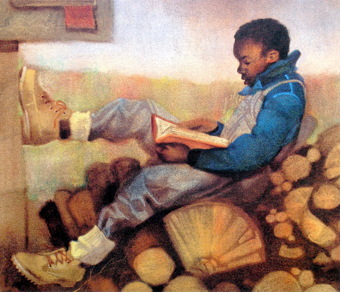
Deadlines, editorial demands and even the trim size and gutters of the book became limits and hindrances to the creative process. The pressure of producing art in a stifling environment became the norm and began to take a toll. One day I sat down at my table and could not move forward. I had reached the point of burn-out! My instincts told me to get away. This is how I discovered the powers of walking outside at midnight. A midnight walk outside in any given season you’ll find the mind takes a rest from the pressures of production and allows the doors of the brain to fling wide open with the breezes of inspiration! It matters not whether country or town, noisy or quiet, as long as you can see the sky in it’s velvet caress. You may even catch a glimpse of the Muse’s own shadow, flitting about on the peripheral. Try it! Think hard about what you want to produce be it picture or prose. Then get up! Walk out into the night giving it not a single thought more. You will find upon your return, the sprouts of fresh ideas ready to grow and…
I can be inspired sometimes with a single image that will be so full of emotion as to lead to several more paintings and even the entire book.

I can be inspired by a visit to a museum or gallery with masterworks on display.
I can be inspired with rejection of my idea.


The image above was to be cut from the book when my sketch was unclear and the editors thought the ballet master’s hands belonged to the little girl. I poured a little more into the art after that!

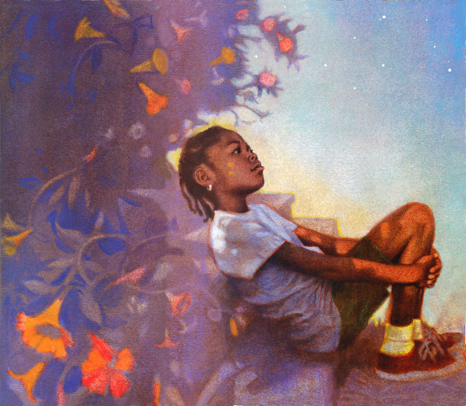

The one thing that inspires me most, more than midnight walks, more than a museum, even more than rejection is……
A text that sings, that embraces my imagination and injects it with energy. Good story inspires great art!


Floyd Cooper has illustrated more than 100 children’s books and has been honored with the Coretta Scott King award for his work. He recently released MAX AND THE TAG-ALONG MOON, one of only five books he both wrote and illustrated.

On being a children’s author Floyd says, “Giving kids a positive alternative to counteract the negative impact of what is conveyed in today’s media is a huge opportunity.” Floyd lives in Pennsylvania with his wife (and agent) Velma and two sons.
You can view the full scope of his work at FloydCooper.com.


 by Barbara Krasner
by Barbara Krasner
In a million years I’d never have thought my first children’s book would be a picture book. While I was working mostly on YA historical novels during my MFA program at the Vermont College of Fine Arts, a friend teased and said picture books would be my future.
I write picture book biographies. Well, no, that’s not quite right. I write picture book historical fiction, because I invent dialogue based on real-life stories. And I did the unthinkable in my picture book, Goldie Takes a Stand! Golda Meir’s First Crusade—I wrote it in first person. The version I submitted to publisher Kar-Ben, the Jewish imprint of Lerner Publishing, was 1400 words (don’t worry, it got slashed).
There was no other way to write about Golda than in first person, because her voice was so strong. I had many other picture book drafts, but I knew I had something special with Golda. It all began when I was attending two weeks of retreat at the Highlights Foundation. Between the two weeks I had to attend an event at the Touro Synagogue in Rhode Island. I perused the shelves at the Highlights farmhouse and saw Golda’s autobiography, My Life (which I learned recently she didn’t write). Over the weekend, I read it and found a snippet about how as a child, Golda staged a fundraising event in Milwaukee, where she and her family had settled as immigrants from Russia, to buy schoolbooks for classmates. She mentioned a newspaper article had appeared about the event. Back home, I contacted the Jewish Historical Society of Milwaukee and the archivist knew exactly which article I was talking about. He sent it to me.
I wrote the draft on a Saturday night. Initially, I wrote it in third person, but that didn’t seem quite right. When I changed to first, the voice and story fell into place. I interpreted a true event but had to fill in the gaps to present the problem Golda and her friends faced. I invented dialogue. But the event itself was true and documented.

I drafted the story in October 2011. I took it to workshops. I submitted the manuscript to Kar-Ben the following April and received an offer in June 2012. The book was published in August 2014.
I had been researching the story of the MS St. Louis since 2010, when I interviewed eight survivors of the ill-fated voyage. In 1939, this ship of nearly 1,000 German-Jewish refugees left Germany for safe haven from Nazism in Cuba. But when it arrived there, the passengers weren’t allowed to disembark. Denied refuge, the ship roamed the Atlantic until a philanthropic organization negotiated landing in Antwerp and distribution of the passengers to England, France, the Netherlands, and Belgium.
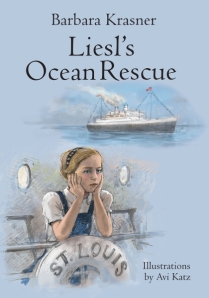
One of the women I interviewed, Liesl Joseph Loeb, was the daughter of the head of the passenger committee. I wrote a middle-grade narrative, but the story was difficult to tell, because so much happened that children on board wouldn’t have known about. Then it dawned on me to focus on Liesl in a picture book. That became Liesl’s Ocean Rescue, coming out very soon from Gihon River Press, a specialized Holocaust publisher. Again, I took dramatic license with Liesl’s story, but it is based on her interview and true events.
What I learned is absolutely true:
- Go with your gut. If something doesn’t feel quite right, change it.
- Make a weakness a strength. Some publishers rejected my manuscript, because it was in first person. I decided to make that my story’s strength.
- Keep trying. I graduated from VCFA in 2006. Eight years later my first children’s book appeared. I still have those YA historical novels under the bed. Maybe they’ll make it out some day, but for right now, my focus is on picture book biographies.
- Get your manuscript vetted. Even though my picture books are fictionalized, they are based on true events. I needed to find subject matter experts who could vet the manuscripts.
- Write a biography only if the subject wrote an autobiography. Since these two picture books, I’ve drafted a few biographies, now with my agent. But these stories are true—and are in first person.

Barbara Krasner holds an M.B.A. in Marketing from Rutgers University and an M.F.A. in Writing for Children & Young Adults from the Vermont College of Fine Arts (VCFA). She is currently an adjunct professor in the English department at William Paterson University, teaching introductory and advanced creative writing, fiction writing, and children’s literature. GOLDIE TAKES A STAND: GOLDA MEIR’S FIRST CRUSADE, released in 2014 with Kar-Ben Publishers, is her debut picture book. LIESEL’S OCEAN RESCUE is due from Gihon River Press this December.
You can connect with her at BarbaraKrasner.com and follow her on Twitter @BarbaraKrasner.

Barbara is giving away a copy of GOLDIE TAKES A STAND!
This prize will be given away at the conclusion of PiBoIdMo. You are eligible for this prize if:
- You have registered for PiBoIdMo.
- You have commented ONCE ONLY on today’s post.
- You have completed the PiBoIdMo challenge. (You will have to sign the PiBoIdMo Pledge at the end of the event.)
Good luck, everyone!


 by Corey Rosen Schwartz
by Corey Rosen Schwartz
Are you having trouble getting to 30 ideas? If you are, the reason is most likely because you are censoring yourself. DO NOT LISTEN to that internal voice saying “No, don’t put that one down. It’s too overdone. Or too bland. Or too half-baked!” (Okay, I did not mean for there to be any food analogies here, but now that there are, maybe I should run with it?)
PiBoIdMo is the one time that I focus on quantity over quality. Your ideas do not have to be irresistible. They can be too vague, too corny, too irreverent, or too __________ (substitute your own preferred flavor of criticism here).
It doesn’t matter!
WRITE DOWN EVERYTHING from soup to nuts!
It does not need to be a hard-boiled synopsis. It can be just a title, a trait, a concept. Any tiny morsel is worth recording. If I waited for a full-blown plot to hit me, I’d never get to #2 on my list.
WRITE DOWN EVERYTHING!
Oh, did I say that already? Well, I’m sure some of you are still going to hesitate. “I can’t just write down a character name, can I?” YES, YOU CAN. And you should.
Think of it as collecting ingredients. The more ingredients you have to choose from, the more concoctions you can whip up.
Once you have a substantial list, then you can get cooking!
Look at your list. Look at last year’s list. Which ingredients can be combined?
In 2009, I was obsessed with Goldilocks. Here are two ideas from my list:
- Fractured fairy tale with a surprise twin? Goldilocks has a twin sister, or Little Red? Little Pink? Tawnylocks? Brownilocks?
- Using fairy tales to teach fractions. Goldilocks and the three and a half bears? How can you have half a bear? Bear in Mommy’s tummy? Could mama bear deliver right in the middle of the story?
Neither idea went anywhere, but those two concepts nagged at me…twins, fraction, twins, fractions…both seemed like topics I wanted to pursue.
And then during PiBoIdMo 2010, it hit me—the perfect way to combine the two!
TWINDERELLA: A FRACTIONED FAIRY TALE
Cinderella and her twin sister share everything. They each do half the chores—the chopping, the mopping, the baking. They each take half the fairy godmothers goodies. But when they each spend half the night dancing with the prince, and they both fall in love, they have a problem. After all, you can’t split a prince in half. Or can you?
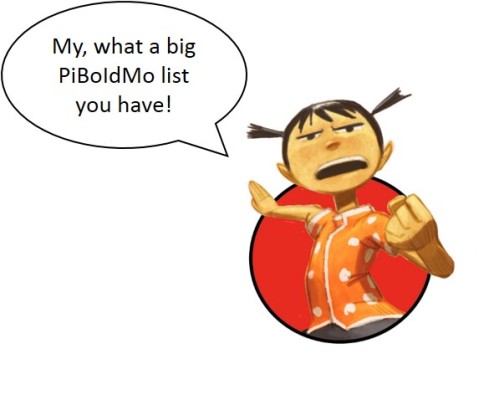

So WRITE DOWN EVERYTHING. And let it all simmer.
And soon you’ll be ready to get cooking!

Corey Rosen Schwartz has cooked up a potpourri of fractured fairy tales and rhyming picture books. She lives with her husband and two children in Warren, NJ and as irony would have it, she is utterly useless in a kitchen!
Twitter: @CoreyPBNinja
Facebook: www.facebook.com/CoreyPBNinja
Website: http://www.coreyrosenschwartz.com


Corey is giving away a signed copy of her latest fractured fairy tale, NINJA RED RIDING HOOD.
This prize will be given away at the conclusion of PiBoIdMo. You are eligible for this prize if:
- You have registered for PiBoIdMo.
- You have commented ONCE ONLY on today’s post.
- You have completed the PiBoIdMo challenge. (You will have to sign the PiBoIdMo Pledge at the end of the event.)
Good luck, everyone!


 by Josh Funk
by Josh Funk
Someday someone will ask me why I write picture books. I won’t say “because I have stories that must be told” or “because my words are so important, all children simply must read them.” And I definitely won’t say “because I want to be rich and famous.”
I write picture books because I have funny ideas in my head that I think would entertain children.
But most importantly, I can’t draw. I mean, I’m allowed to draw, but I’m terrible at it. This was as good as I ever got as an artist…
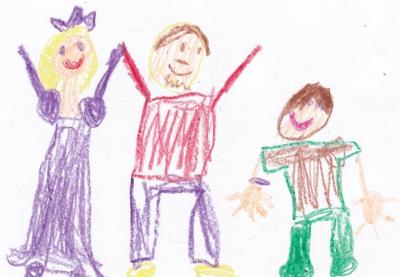
I drew this picture yesterday.
So what’s the easiest way to get these ‘entertaining’ thoughts out of my head and allow them to be visualized by me (and others)?
Write them down …
and hope that many …
many …
years later …
they’ll be published as picture books.
And in general, PiBo-ers, that’s how I come up with my ideas. I think of something I’d like to see illustrated. Something new that I haven’t seen before. Something that will make me laugh (and hopefully make children laugh). Something that an illustrator will have fun with.
Often this comes as interesting characters or their names. See: Lady Pancake and Sir French Toast.
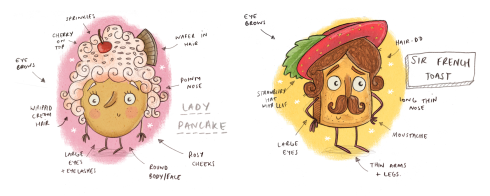
It was harder to figure out what they should do. How do I fit these two into a plot with conflict and tension?
*Ding* They’re fighting over syrup (obviously). What started out as a quasi-political debate about who deserved the syrup more (I wrote the first draft around the 2012 presidential elections) needed more action and a bigger setting.
So I turned once again to my rationale for writing picture books: what would I find entertaining to see illustrated?
They’ll race for the last drop of syrup throughout an entire refrigerator landscape! 27 drafts and 45 rejections later I had LADY PANCAKE AND SIR FRENCH TOAST (Sterling, Oct 2015). [illustrations are by the fantastically talented Brendan Kearney]
Sometimes the answer comes in the way of an interesting situation. A boy and a dragon become pen pals? Ooh, that would be fun! But again, there’s no plot (meh, who needs a plot when you have dragons and an interesting situation? See: DRAGONS LOVE TACOS). But it still needed more.
What would be entertaining to see illustrated? Here I used the ‘what if’ technique. What if the boy thought he was writing to a boy … and the dragon thought he was writing to a dragon? That might make for some funny pictures due to misunderstandings?
16 drafts and several title changes later I had DEAR DRAGON (Viking, Winter 2016).
So if you want to see a Pancake run through Broccoli Forest and past Orange Juice Fountain …
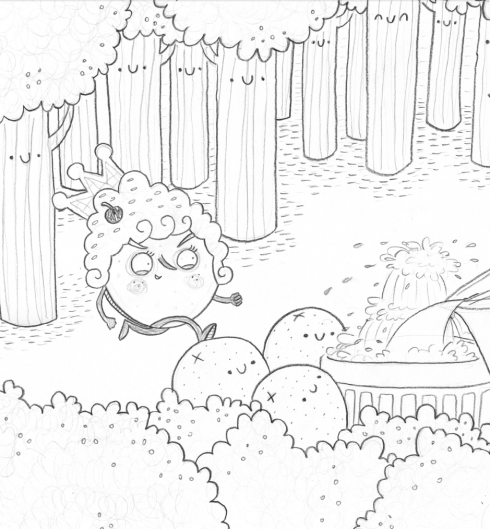
Or you want to see a piece of French Toast go skiing …
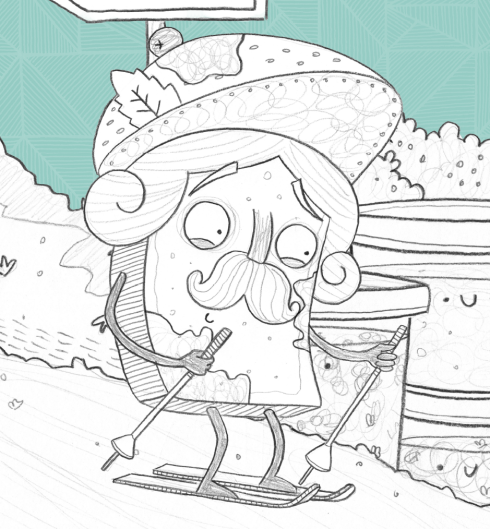
Then just make sure it has an interesting hook, compelling characters, a riveting plot, and is appropriate for ages 0-10.
What do you want to see illustrated?

Josh Funk lives in New England with his wife and many many children. He is the author of the forthcoming picture books (all written in rhyme) LADY PANCAKE AND SIR FRENCH TOAST (Sterling, 2015), DEAR DRAGON (Viking/Penguin, 2016), and PIRASAURS! (Scholastic, 2016). Josh is terrible at writing bios, so please help fill in the blanks. Josh enjoys _______ during ________ and has always loved __________. He has played ________ since age __ and his biggest fear in life is being eaten by a __________. Find out more information at www.papajfunk.com, on Twitter @papajfunk, on Facebook at Josh Funk Books, at Victimless Rhyme, on goodreads, or the end of the ‘F’ section at a library in the future (time machine required).

As Josh does not (yet) have any books published, he is giving away FIVE signed books from his critique family: THE RAINDROP WHO COULDN’T FALL by Kirsti Call, REX WRECKS IT! by Ben Clanton, MONSTER NEEDS A CHRISTMAS TREE by Paul Czajak, RUTH THE SLEUTH AND THE MESSY ROOM by Carol Gordon Ekster, and ESTHER’S HANUKKAH DISASTER by Jane Sutton.
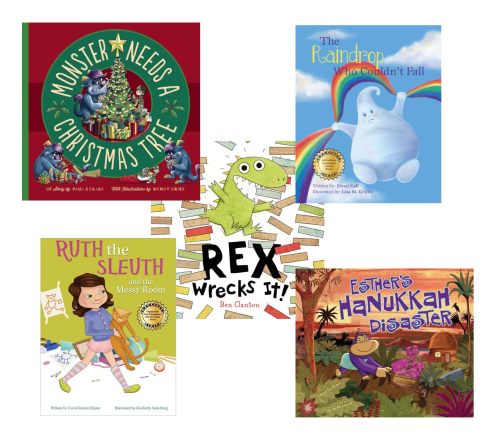
These prizes will be given away at the conclusion of PiBoIdMo. You are eligible for these prizes if:
- You have registered for PiBoIdMo.
- You have commented ONCE ONLY on today’s post.
- You have completed the PiBoIdMo challenge. (You will have to sign the PiBoIdMo Pledge at the end of the event.)
Good luck, everyone!


 by Tammi Sauer
by Tammi Sauer
For PiBoIdMo 2012, my blog post focused on a variety of ways a writer can structure a picture book.
This time around, I wanted to share a different approach to framing a story.
*drum roll, please*
THE HOW-TO… STRUCTURE
The How-To…Structure offers readers information on, you guessed it, how to do something.
Keep in mind, however, this structure isn’t just a list of bland, disjointed steps for accomplishing a task. Nope. Nope. Nope. These steps (along with the art) need to tell a real deal story. There should be a beginning, middle, and end. There should be characters, conflict, plot, setting…. There should be opportunities for your readers to feel something.
Some good examples of books that use the How-To… Structure are as follows:
Vampirina Ballerina by Anne Marie Pace, illustrated by LeUyen Pham

So You Want to Be a Rock Star by Audrey Vernick, illustrated by Kirstie Edmunds
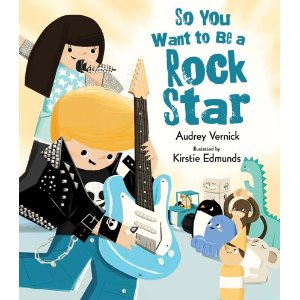
How to Babysit a Grandpa by Jean Reagan , illustrated by Lee Wildish

How to Wash a Woolly Mammoth by Michelle Robinison, illustrated by Kate Hindley

Your Challenge: Jot down a few possibilities for some How-To… books of your own. It might help to think in terms of a title. Even easier, just fill in the blanks to the prompts below and see where they take you.
How to__________
Guide to Being a ________
The __________ Handbook
This is what happened when I just filled in those blanks:
How to Catch a Dragon
Guide to Being a Big Brother
The Pirate’s Handbook
Extra Credit: Analyze the picture books I mentioned earlier in this post. How did those authors incorporate the How-To…Structure? Do you see some sort of story arc in these books? Did you notice any special word play? The rule of threes? What did you find particularly satisfying in those books?
Happy brainstorming, everybody!

Tammi Sauer is the author of Nugget & Fang, Princess in Training, and many other picture books. She has another eleven under contract. Her latest manuscript sold at auction. It followed the How to…Structure. Ooh.
You can visit Tammi at tammisauer.com and at picturebookbuilders.com.


Tammi is giving away a signed copy of Nugget & Fang which won the 2014 Oklahoma Book Award, made the 2014 Texas 2X2 Reading List, and will be one of the featured books at the 2015 Scholastic Book Fair. Nugget & Fang was a PiBoIdMo 2009 Success Story.
Tammi will also give a picture book critique to another lucky duck winner.
These prizes will be given away at the conclusion of PiBoIdMo. You are eligible for these prizes if:
- You have registered for PiBoIdMo.
- You have commented ONCE ONLY on today’s post.
- You have completed the PiBoIdMo challenge. (You will have to sign the PiBoIdMo Pledge at the end of the event.)
Good luck, everyone!


by Molly Idle

It has been said that an infinite well of creativity springs within each and every one of us.
Well, I wasted a lot of time trying to draw inspiration from mine with a bucket that was already full. At least, that’s what I came to realize after years of worrying that my well had run dry.
Before I came to that realization however, this is the conversation I had with myself every time I was working on a book…
Me 1: I like the way this idea is shaping up. It’s all good right?
Me 2: Are you kidding me? Sure, this idea is ok, but what if I can’t think of an idea for the next book? Or the one after that? What if I’ve used up all my good ideas?!
Me 1: Um…I don’t have an answer to that.
Me 2: See! I’m out of answers just like I’m out of ideas!
Me 1: Oh. No.
*head/desk in a schlump of despair*
Thus I spent my time working on every project thinking that it would be my last.
Then, one day, as I boxed up a finished book, sent it off, and thought… “Well, that’s it then, I’m finished, this is the end…”
*Plink!*
A new idea sprang up in my mind.
And this mental conversation ensued…
Me 1: I have a great new idea!
Me 2: Wow, that’s lucky! I thought we were all out of new ideas…
Oprah: Luck is the moment when preparation meets opportunity.
Me1: Oprah, how did you get in here?
Oprah: (smiles mysteriously, then vanishes in a mist of chai tea)
Me 2: Okaaayyy…
When I finished up the next project it happened again (sans Oprah and chai). Another new idea came to me within days!
Mental conversation…
Me 1: Coincidence?
Me 2 : I think not.
Me 1: Alrirght then, prove it…
Me 2: Alright then, I will!
So, I started consciously keeping track of how and when I came up with new ideas, and what I discovered was this… It wasn’t luck. That is to say, it wasn’t random.
I discovered that my brain seemed to have a finite number of ideas it could hold as I worked on them. When my brain was full, I could try to pull up ideas from the wellspring of creativity all I wanted, and not be able to draw up so much a drop of inspiration. But, through preparing one idea, drawing it out—I simultaneously created the space, or opportunity, to draw up another.
So, Oprah, with her mysterious mental chai mist, was right! “Luck is the moment when preparation meets opportunity.”
Ergo, Luck = Work
Now, that’s not to say that every idea I draw up gets poured out into a picture book.
Sheesh, no!
Some ideas are forgotten (just like that two day old cuppa chai tea left sitting on my desk).
Some ideas get poured straight down the drain.
Some ideas may simmer for a bit, then get poured down the drain, only to be replaced by another idea that may not work out either, and another… and another!
But, as long as I keep working, sometimes, sometimes, I get lucky. Sometimes, I draw up an idea from the well, and it pours it out, through pencil and paper, into a picture book.


Molly Idle has been drawing ever since she could wield a pencil. But while she started scribbling before she could walk, her professional career as an artist began slightly later…
It was upon her graduation from Arizona State University, with a BFA in Drawing, that Molly accepted an offer to work for DreamWorks Feature Animation Studios. After five years, a number of film credits, and an incredibly good time, she left the studio and leapt with gusto into the world of children’s book illustration!
Molly now lives in Arizona with her brilliant husband, two wonderfully mischievous sons, and two snugly cats. When not making mischief with her boys or watching old Technicolor musicals, she can be found at her desk scribbling away, with a pencil in one hand and a cup of espresso in the other- creating a plethora of profoundly whimsical picture books!
www.idleillustration.com
Twitter: @mollyidle
Facebook: Idle Illustration
Instagram: @mollyidle

Molly is giving away a signed FLORA AND THE FLAMINGO poster!

This prize will be given away at the conclusion of PiBoIdMo. You are eligible for this prize if:
- You have registered for PiBoIdMo.
- You have commented ONCE ONLY on today’s post.
- You have completed the PiBoIdMo challenge. (You will have to sign the PiBoIdMo Pledge at the end of the event.)
Good luck, everyone!


 by Sandra Tayler
by Sandra Tayler
I never had an ambition to become a picture book author. I know it is a thing that many people dream of doing. Their brains burst with rhythm and rhyme. They long to have their words matched with glorious pictures and put on shelves for children to love. I tumbled into it because I had a child and she desperately needed a story. She was struggling and hurting. I knew that the right story could help her. I looked for it at the library and in bookstores. I didn’t find it, and so I wrote it instead. This was how Hold on to Your Horses was created. I thought I was done, but my daughter still struggled and I knew there was another question to answer, so I wrote The Strength of Wild Horses. Both stories came directly from the need of a child. So that is my advice to all those participating in PiBoIdMo. If you’re struggling to find ideas, go spend time with some children.
I once read an article that described children’s play as taking place in the Future Possible tense. You can hear it in the intonations of the kids. They have an idea—something they hope will be accepted into the mutual game—So they make a statement, but give it the intonation of a question.
“And then I grew wings?” says one child.
The other nods and says, “And I pulled out my rocket pack and we flew to the mountain together?”
Each is part statement, part question. It is an expression of what might be possible in the next part of the game. Many adults would do well to think in the future possible tense. PiBoIdMo writers would do well to sit down with a note pad and scribble notes as fast as the kids can imagine. The games of children will teach you magic and whimsy that you can carry with you to the picture books you want to write. Children know that sometimes the best answer is to sprout a pair of wings (or a jetpack) and take off for the next mountain.
Stories are gifts to the children who read them. Your story may be a gift of whimsy or delight. It may be a solution to a problem. It may be a necessary lesson. Like gifts, these stories can come in all sorts of wrappings. They may be full of rhyme or they may be simple prose. The pictures may be simple or elaborate. If you’re not sure yet which story you want to tell, go spend time with the people you want to tell it to. Listen to them. Learn what they love, what they worry about, what they cry over. Throw all of this into the pot from which you draw your ideas and let it simmer for a while. The result will be something delightful or useful, and perfectly suited to your audience.

Sandra Tayler is a writer of essays, children’s books, picture books, speculative fiction, and blog entries, all of which can be found at onecobble.com . She has two picture books in print, two essay books, ten years of blog entries, and a novel in progress. Sandra can be found online at OneCobble.com or on twitter @SandraTayler. When she is not working, Sandra spends time with her house, her four kids, and her cartoonist husband, Howard Tayler.

Sandra is giving away a matched set of picture books Hold on to Your Horses and The Strength of Wild Horses. Perfect reading for anyone who has a child filled with wild ideas.


This prize will be given away at the conclusion of PiBoIdMo. You are eligible for this prize if:
- You have registered for PiBoIdMo.
- You have commented ONCE ONLY on today’s post.
- You have completed the PiBoIdMo challenge. (You will have to sign the PiBoIdMo Pledge at the end of the event.)
Good luck, everyone!


by Deborah Freedman
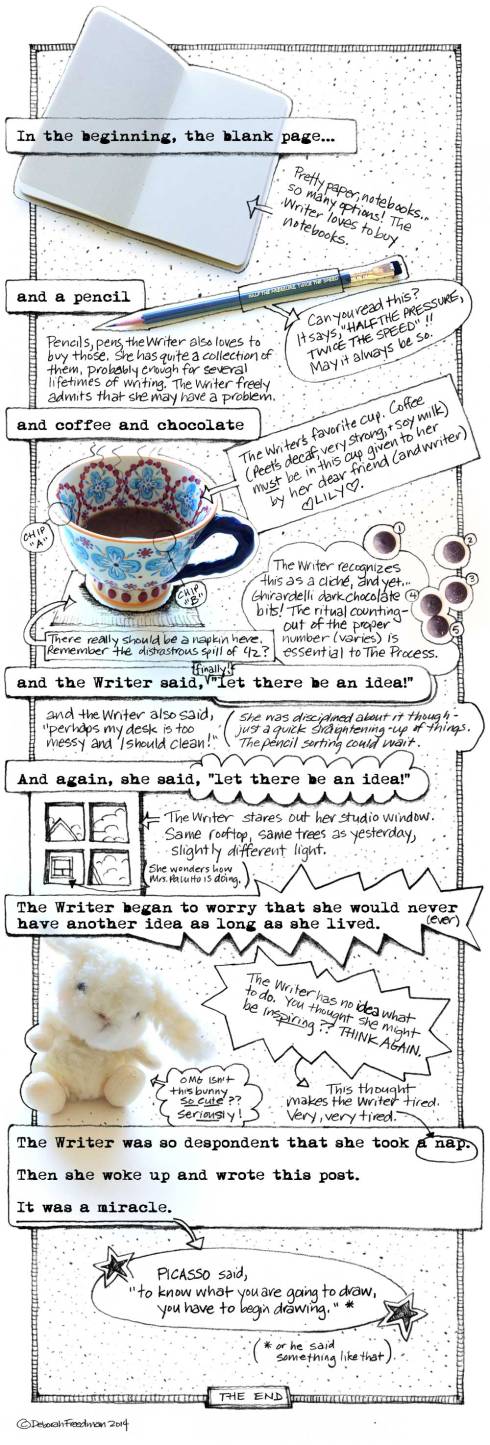
Click for full size.

Deborah Freedman was an architect once-upon-a-time, but now she loves to build worlds in children’s picture books. She is the author and illustrator of Blue Chicken, The Story of Fish & Snail, Scribble, and By Mouse & Frog—to be published by Viking in 2015. Deborah lives in a colorful house in Connecticut, where she is busy at work on her next books.

Deborah is giving away a signed copy of THE STORY OF FISH & SNAIL.
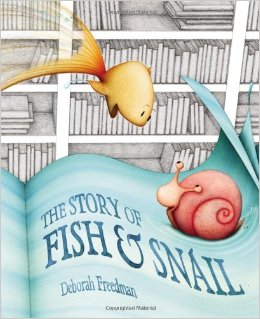
This prize will be given away at the conclusion of PiBoIdMo. You are eligible for this prize if:
- You have registered for PiBoIdMo. TODAY IS THE LAST DAY TO DO SO!
- You have commented ONCE ONLY on today’s post.
- You have completed the PiBoIdMo challenge. (You will have to sign the PiBoIdMo Pledge at the end of the event.)
Good luck, everyone!


 by Jennifer Arena
by Jennifer Arena
When I was an editor at Golden Books, I was lucky enough to work with many wonderful authors, but one who stood out for his good humor, his generosity, and his absolute joy in writing for kids was George Stanley. Around Golden, we had a nickname for him—Captain Hook, because, more than any other author we’d worked with, George had a knack for coming up with books with hooks, books that kids really and truly wanted to read based on the idea alone.
The first book I edited of George’s was Ghost Horse. It had a horse . . . who was a ghost! What’s cooler than that? The second book was Snake Camp, about a snake-phobic kid who accidentally gets sent to a camp for snake lovers. Both were brilliant, attention-grabbing ideas that kids were sure to like. (And they did!)
My boss and I began to joke that George had a sure-fire way of coming up with great ideas—a George Stanley Idea Generator. Back then, we pictured a hat, full of slips of paper, each printed with an idea that kids loved to read about. He’d pull out two pieces of paper, and no matter how crazy, mash those ideas together in one book.
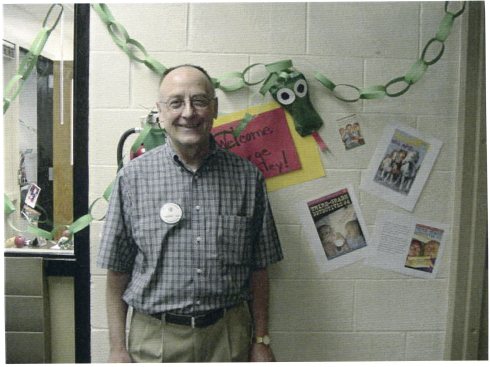
George sent me this photo of a school visit he did. The kids made a giant paper chain snake in honor of SNAKE CAMP.
By that point, I had written a few books with hooks, usually nonfiction titles on cool topics, like Pink Snow and Other Weird Weather or Bugs, Bugs, Bugs, and, yes, my own snake book, called Slinky, Scaly Snakes, but the idea of mashing together hooks opened a new window on fiction for me. Everywhere I looked, I saw “George Stanley”-type ideas, not only in kids’ books, either. There were kids’ TV shows like Dinosaur Train, adult bestsellers like Pride and Prejudice with Zombies, and movies like Snakes on a Plane. Last year a true George Stanley-type idea became a cult hit—Sharknado, anyone?
So here it is, your shortcut to inspiration! Just pick any of these two words (or throw in some hook words of your own), and you’ve got a book idea. How do you know what a hook is? Animals are always popular. Holidays are great hooks because stores, teachers, and librarians feature these books seasonally. Don’t forget disasters and the supernatural. Dinosaurs are The Once and Future Hook, with dogs a close second, while something like ninjas probably wasn’t popular fifteen years ago, but is surging big time now.

Try it for yourself! Spider Baseball? I’d buy that. Dream Witch? Camp Halloween? Puppy Palace? Wait . . . I think that one has been done.
Of course, the idea is the easy part, the 10% of the iceberg that shows above the water. Now you have to find the inspiration in that idea and figure out what the story is, which is the other 90% of the iceberg. What does Pirate Panda want? What are the obstacles facing her? How will she overcome them? And that, PiBoIdMo’ers, is what being a writer is all about.
Last fall, I had a genuine George Stanley-type picture book published, called 100 Snowmen. ((jpeg cover of 100 Snowmen)) The number 100 ties into a holiday, the 100th Day of School, and snowmen are both seasonal and, especially after Frozen hit, very popular. I know that somewhere George Stanley was smiling down at me. “Yes, grasshopper,” he’d say. “That’s how it’s done.”


Jen Arena writes, edits, and mashes together ideas for everything from easy-to-reads to picture books to early chapter books, including her latest, a bilingual board book with Little Brown, Besos for Baby. Her picture books Lady Liberty’s Holiday and Marta Big and Small will be published in 2016 by Knopf and Roaring Brook respectively. Visit her on twitter at @hallojen or at her website: JenArenaBooks.com.


What? The George Stanley Idea Generator wasn’t enough of a prize? Okay . . .
Jen is giving away a thirty-minute brainstorming session/Q&A/editorial consult phone call. She has twenty years of experience as an editor with Putnam, Golden Books, and Random House and has been writing for kids just as long. Ask away!
This prize will be given away at the conclusion of PiBoIdMo. You are eligible for this prize if:
- You have registered for PiBoIdMo. TODAY IS THE LAST DAY TO DO SO!
- You have commented ONCE ONLY on today’s post.
- You have completed the PiBoIdMo challenge. (You will have to sign the PiBoIdMo Pledge at the end of the event.)
Good luck, everyone!


b y Sudipta Bardhan-Quallen
y Sudipta Bardhan-Quallen
It’s still early in Picture Book Idea Month, and hopefully you’re all still overflowing with ideas that you can put down on paper. It does get tougher as the month continues, but bravo to you for taking up the challenge!
You’re going to come up with a lot of different kinds of ideas. You’ll think of titles, puns, and images that you see in your mind’s eye. You’ll imagine complicated scenarios and Holy Grails. You’ll draft punchlines and scenes that tug at the heart. All of these varied things can eventually grow into a beautiful, successful picture book.
But no matter what you start with, character is almost always the key to crafting a book that will be published.
POPPYCOCK! you say. CODSWALLOP! BUNK! After all, there are so many other things we hear about that make editors want to publish a manuscript. Compelling plots. Flawless writing. Powerful marketing hooks. And those are all vital things! Your plot has to be gripping and unique. The writing must be impeccable and beautiful to read. There has to be hooks to help the book sell.
But all of those things pale in comparison to the character.
It is the character that the reader will fall in love with. It is the character who he will root for. It is the character he will draw on his fan mail to you. It is the character who will live on in his imagination for week, months, years to come.
It is the character you have to get right.
Let’s talk about some ways to do that.
Character is Like the Salt

Every once in a while when I’m cooking dinner, I totally forget to add salt. The meal I end up with is nothing short of disgusting and inedible. Salvageable, yes—as long as I add some salt to it. But without that one ingredient, dinner is nothing like what it is supposed to be.
Character is the salt in your picture book idea.
Some meals use a lot of salt. Others, just a sprinkling. But salt is essential. The same holds true for character.
Even in a high concept idea (which is becoming increasingly popular in picture books), you still need that sprinkling of salt, errrr, character. Here’s an example: I have a book coming out soon called RUTABAGA BOO (which will be illustrated by the uber-talented Bonnie Adamson). The entire book is about the unbreakable bond between a son and his mother. Whenever the son needs his mother, he says, “Rutabaga!” To show that she is there, she answers, “Boo!”
On the surface, it may not seem like there is a lot of character in this idea. (I mean, how much character development can you show in 22 words?) But while the heart of this story is the mother/son bond, what draws the reader in is what you learn about the characters—and how much those details endear the characters to the reader. Every spread tells you something more about the characters—what they like to do, what scares them, what makes them feel better. The characters in this case may just be a sprinkling of salt—but without them, the story doesn’t mean nearly as much to the reader.
Think Wedding Cake, Not Cupcake

Let’s belabor the cooking theme some more.
As you are thinking of you PiBoIdMo ideas (and you are focusing on character because you, like me, believe character is the key), make sure you incorporate layers from the beginning. Just like a wedding cake is more impressive because of its tiered layers, you want to create a character that has, well, tiers and layers. Don’t let your idea stand at “Cindy wants a new puppy.” Push it to the limit (even at the idea stage):
- Can you enhance the theme? “Cindy wants a puppy so she can join the kids who walk their dogs afterschool and make some new friends” or “Cindy wants a puppy so she isn’t so lonely”
- Can you ratchet up the conflict? “Cindy wants a puppy but her father hates dogs” or “Cindy wants a puppy – but she only wants responsibility for the top half (the bottom half – and anything that comes out of the bottom – should be her brother’s responsibility!)”
- Can you make your character a study in contradictions? “Cindy wants a new puppy—and yet, she is allergic to dog hair!” or “Cindy wants a puppy but she already has a kitten who is deathly afraid of dogs”
Every time you add a layer to the idea, you make your story inherently more interesting. And no matter where you add the layer, try to leverage into making the character more complex.
To go back to the RUTABAGA BOO example, layers were very important to make that story meaty enough to merit a hardcover picture book. It wasn’t enough to say that the son wanted to be with his mother in a whole bunch of different scenarios. When I wrote the story, I thought about all the different reasons that children want their parents. Would he look for her when he was hungry? When he was scared? How would those look different? How about when the boy was excited – how would he look for his mother then? When he was lonely? When he was tired? What kinds of scenes would show all these diverse interactions that create a relationship?
I started with the cupcake model of “sons like having their mothers nearby” and added tiers to make the story mouthwatering. In 24 words (and Bonnie’s beautiful illustrations, the reader is left with a full depiction of the mother / son bond – and meets characters that they can identify with.
Envision Your Character
After I’ve lectured you on the importance of character, I’m sure you’re all committed to brainstorming great characters every day of PiBoIdMo 2014. So now I’d like to give you a tool to help you with that.
When I teach kids at author visits about developing characters, I give them a graphic organizer to help them get their thoughts down on paper. As it turns out, that organizer works really well for picture book authors, too. (I know. I use it!) So here you go, PiBo-ers! Your own Character Graphic Organizer to help you develop your ideas…
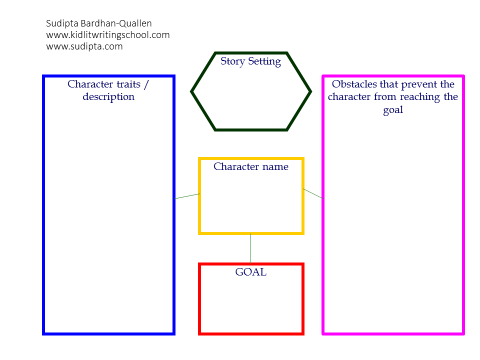
Click for full-sized, printable version.

Sudipta is an award-winning author of over 40 books and the co-founder of both Kidlit Writing School and Kidlit Summer School. Her books include DUCK DUCK MOOSE, TYRANNOSAURUS WRECKS, ORANGUTANGLED, and over thirty more books that have been acclaimed by the Junior Library Guild, the California Reader’s Collection, the Bank Street Books Reading Committe, the Amelia Bloomer list, and many more. Find out more about her by visiting SUDIPTA.COM or her blogs NERDYCHICKSRULE.COM and NERDYCHICKSWRITE.COM.
Facebook: https://www.facebook.com/SudiptaBardhanQuallen
Twitter: @SudiptaBQ
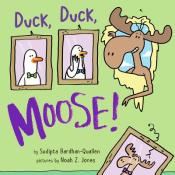



One lucky commenter will receive a free picture book course at Kidlit Writing School! Our next picture book course will be on character development in picture books. The winner can opt to take that course or any other picture book course offered in 2015.
This prize will be given away at the conclusion of PiBoIdMo. You are eligible for this prize if:
- You have registered for PiBoIdMo.
- You have commented ONCE ONLY on today’s post.
- You have completed the PiBoIdMo challenge. (You will have to sign the PiBoIdMo Pledge at the end of the event.)
Good luck, and happy brainstorming!
As a bonus, ALL PiBoIdMo participants who register for a class during PiBoIdMo can get a discount on picture book courses at Kidlit Writing School by going to the secret PiBoIdMo page: http://www.kidlitwritingschool.com/piboidmo-special-registration.html. Find the coupon code to get your discount—just make sure you register before November 30!


 by Pat Zietlow Miller
by Pat Zietlow Miller
“What process do you follow to write your stories?” I’ve heard that question more frequently as I’ve sold more picture books, and I never know how to answer.
The people asking usually look as if they’re waiting for a golden ticket to inspiration. Like maybe I’ll say that I always walk three times around my living room, stand on one foot, hum the “Star-Spangled Banner” and then run to the computer to start writing before the muse I’ve conjured flies away. Then, they can do the same thing and wait for their own inspiration to strike.
When I tell the truth—that I don’t have a specific writing process—they seem disappointed. But, trust me. I’m doing them a favor. If they knew how things really go down, they might give up writing altogether. I’m a little haphazard.
But, just for you, in honor of PiBoWriMo, I am pulling back the curtain and sharing my process, such as it is. Here’s how I wrote WIDE-AWAKE BEAR, which is coming from HarperCollins in 2017:
Step One:
Have a cranky child.
Three years ago, my youngest daughter was happily napping on the couch. When I woke her to take her to volleyball practice, she had a world-class meltdown. There was wailing, tears and shouting. I tossed her into the car and took her anyway. Afterward, when she was calm, I said, “What was THAT all about?” Her response? “I was a hibernating bear. You woke me up, and I went into a bear frenzy.” (Author’s note: Is that not the best response ever? I love this kid.)
Step Two:
Forget about that adorable incident.
I filed that wonderful remark under the category of “Cool Stuff My Kid Has Said” and went about my business. For several years.
Step Three:
Be bored on a plane.
On a plane ride home from Yellowstone Park, where I was disappointed I hadn’t seen a bear, I thought I should use the flying time to do something productive. So I grabbed a notepad and pen and wrote a story about a bear cub who wakes up in the middle of winter and goes into a bear frenzy.
Step Four:
Listen to your critique group say, “Meh.”
I shared this story with my critique group and got a lukewarm response. They thought the bear cub got too cranky and deserved a timeout. They also didn’t understand why he got so angry. So I adjusted and reworked the story over several weeks. The title changed, and the storyline morphed into a bear cub who woke up midwinter, got scared and couldn’t fall back asleep. I shared it with some more writing friends and adjusted it even more. Then, I stopped, because I didn’t know what else to do.
Step Five:
Let it sit on your desktop for a while.
I wasn’t sure the story was ready. So I worked on other things and didn’t think much about it.
Step Six:
Send it to your agent on a whim.
Then one day, I opened the file and thought, “This isn’t so bad.” (See how I just glow with self-confidence?) I sent it to my agent, hoping she might give me a few ideas so I could work on it some more. But she thought it was ready to go, sent it out and it sold in about three weeks. That’s my quickest sale ever.
So, there you have it. How to write and sell a picture book in six simple steps. You know just what to do now, right?
I told another writer about my lack of a process, and she said, “You do have a process. It’s organic!” And she is absolutely right, because I’ve never once used pesticides in any of my books.
If there’s anything to learn from my post, it’s that everyone’s process is different. As long as you find something that works for you, you’ll be fine. If you’re not seeing the results you want and feel like your process may be fault, try a few different things.
- Be haphazard—I mean organic—like me.
- Be super-organized like another writer I know who sets her timer for 45-minute chunks and logs her writing time on a chart posted on her office door.
- Try writing mornings or evenings to see if something works better. Try different locations, too.
- Try standing on one foot in your living room and humming the national anthem. (It could work.)
Chances are something will seem more appealing to you and you’ll be well on your way to finding your own inspiration.

To learn more about me, visit PatZietlowMiller.com or follow me on Twitter at @PatZMiller.

If you leave a comment on this post you could be one of two people to win one of two prizes—a signed copy of SOPHIE’S SQUASH (Schwartz & Wade, 2013) to be sent immediately or a signed copy of WHEREVER YOU GO to be sent once it’s released from Little, Brown on May 5, 2015. Each of these books followed a totally different process than WIDE-AWAKE BEAR. I meant it when I said my process was haphazard.
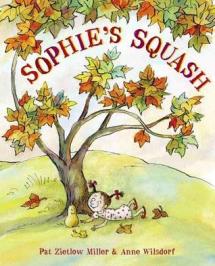
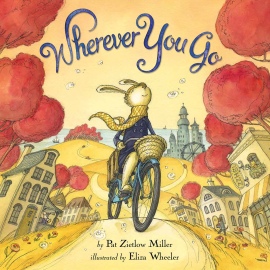
This prize will be given away at the conclusion of PiBoIdMo. You are eligible for this prize if:
- You have registered for PiBoIdMo.
- You have commented ONCE ONLY on today’s post.
- You have completed the PiBoIdMo challenge. (You will have to sign the PiBoIdMo Pledge at the end of the event.)
Good luck, everyone!


 by Karen Henry Clark
by Karen Henry Clark
PiBoIdMo readers arrived today with packed suitcases, believing I had the inspirational ticket for guaranteed passage on the gleaming picture book express.
This is not that train.
Once upon a time I thought I had the golden ticket, but it turned out to be a day pass. Here’s the story.
By the time I was four, I wanted three things: a husband, a daughter, and a book that I wrote myself. I was sketchy about how to accomplish the first two, so I tackled the book. In purple crayon, a popcorn ball rolled through perilous adventures across our living room walls. My mother patiently explained that books belonged on paper, and my father wrote my story on a notepad as I recited it.
I kept writing (on paper) and eventually received a master’s degree in English. I had official jobs, but secretly I wrote picture books.
Then I found my husband, an elementary teacher who believed my stories were wonderful. He read them to his classes and asked students to draw their favorite part. He believed I had promise.
In a twist of fate, I met Florence Parry Heide, a successful children’s author who told me to join SCBW, long before they had added the I to their name. Early newsletters had pages of editors and addresses. I submitted manuscripts for almost seven years. When I complained about my rejections, Florence said, “Do you want to see mine? I have boxes of them.” So I kept trying. An editor finally called because she loved my story, but the project ended when a new publisher was hired. The editor told me not to stop writing, but I did. It seemed pointless.
Then we adopted our daughter Maggie from China. Her government document said: Baby found forsaking. I realized eleven months of her life would always be a blank page. When her first English word was moon, I imagined it had been the magic in her orphanage nights. Perhaps her favorite toys represented animals she had seen in China. I invented nap time tales about her adventures with them.

When Maggie was five, she asked what I had wanted to be when I grew up. I read her the manuscript that had come close to publication. She liked it and said, “You should write more, Mama.” How could I expect her to believe in dreams if I gave up on mine? So I put her on my lap and began to type a story called Sweet Moon Baby.
Rejections arrived, but Maggie’s faith in me never wavered. In second grade, she wrote to me as Editor at Clark House Printing and Loving Company. Not only did she love Sweet Moon Baby, she asked if I had others as “wonderful and enchanting.”

Then one day I received the long-awaited yes I had waited for almost my entire life. Sweet Moon Baby: An Adoption Tale, illustrated by Patrice Barton, was published by Knopf in 2010.

The three-point dream of my four-year-old self came true. Entering the Random House Lobby to visit my editor was my Homecoming Queen moment. At author events when parents announced: “This is our Sweet Moon Baby,” I was proud to have given a lovely name to adopted Chinese children.
But things change. Now my book is out of print. None of my other manuscripts have worked for an editor. My agent search is unsuccessful. I’ve derailed at the station. My engine flew over the edge, crashed at the bottom of the canyon, and someone spray-painted loser on my caboose.
Still, I can’t quit. And for that I thank my mother and the picture books she read to me constantly. Because she grew up on a farm with no electricity or running water, she favored stories about hard work. Wispy princesses and their vain wishes did not interest her. The Little Engine that Could was her favorite. Through chores, we chanted: “I think I can. I think I can. I think I can.”
My mother (and Watty Piper) gave me the metaphor for my life.
Determined little engine that I was, my first story was about a journey.
Sweet Moon Baby was about a journey.
What I’ve come to understand is that success requires more than writing a great story. You have to understand your writing journey. Whether you’re published or not, your writing can derail. Sometimes you land in the canyon, but you can write down there, too. I am.
My adventure is mine, stop by stop. And that’s not failure. It’s just my track.

Karen Henry Clark has been a high school teacher, college administrator, advertising copywriter, newspaper essayist, and book reviewer. Earning ISBN 978-0-375-95709-3 for Sweet Moon Baby: An Adoption Tale was her proudest professional achievement. She chugs on, hoping to earn another one. Meanwhile, she blogs erratically (but with good intentions) on “For All I Can Tell” at www.karenhenryclark.com.

Karen is generously giving away a signed copy of SWEET MOON BABY.
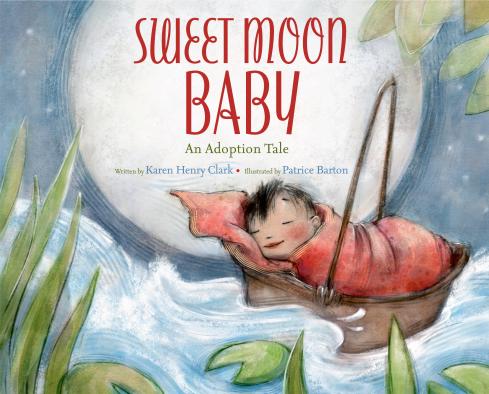
This prize will be given away at the conclusion of PiBoIdMo. You are eligible for this prize if:
- You have registered for PiBoIdMo.
- You have commented ONCE ONLY on today’s post.
- You have completed the PiBoIdMo challenge. (You will have to sign the PiBoIdMo Pledge at the end of the event.)
Good luck, everyone!


 by Kelly Bingham
by Kelly Bingham
Hello, everyone!
CONGRATULATIONS on tackling PIBOIDMO. You are awesome!
Doesn’t it feel amazing to know that some of the ideas you cook up this month may become real, solid books in the hands of real kids someday? Yes, that’s going to happen. It WILL. But before that happens, a few steps have to take place. And one of those first steps, for some of us, will be to take a close look at how we manage our time.
Specifically, our writing time.
First off, I would like to encourage everyone to stick with your PIBOIDMO momentum not only this month, but beyond. Maybe you won’t come up with a picture book idea every single day forever, but you know what? When you sit down to write, you will write something. And any “something” has a better chance of becoming a book than a “nothing.”
That being said: This is as good a time as any to evaluate your writing goals for the remainder of the year and for next year. Want to get published? If so, those goals MUST include making time for writing. Consistently.
Think of it this way. If you ever—for some crazy reason—wanted to run a marathon, would you only train a few hours on the weekends? Or the few times a year you find yourself alone in the house with quiet time? No, you would not. You would train and train and train, every day, no matter what, in “Rocky”-like montages of rain and snow and stairs and fists pumping in the air. You can do that. You can channel your inner-Rocky and do your victory dance at the top of the staircase of your public library, because YOU have the power of imagination AND the discipline of a dedicated writer!!
Let’s lace up your sneakers, tape up those knuckles, head to a meat packing plant to punch some sides of beef, and think about a few things, shall we?
- Are you where you want to be?
- Does your family know you are serious about writing?
- Are you wasting time waiting until you have that extra room cleared out and your writer’s desk set up? Are you waiting until the holidays are over or work settles down or the kids grow up? Are you being non-Rocky-ish?
- Do you make time for your craft and guard that time? Or do you feel guilty for taking time to write, as though writing is a secret, indulgent hobby that you should only do from 2 a.m. to 3 a.m. so that you don’t dare deprive anyone else of something THEY might need?\
“No, Kelly, I do not make time for my craft. My family/job/life is too stressed right now. If you knew what a big deal it was for me to commit to ONE MONTH of writing, you’d be awed.”
I hear you. I do. I’ve been there, too. I wrote Z IS FOR MOOSE while working full time, raising two babies, and completing a master’s degree. I had excuses a-plenty. But the thing is, I wanted to write, and I wanted to be published, really, really bad.
So: If you feel yourself putting writing last—due to external or internal pressure, guilt, mixed messages, embarrassment, misconceptions, or whatever—then I would encourage you to think about that. Again, it comes back to: Do you want to be published? Yes? Well, then. How do you think that will happen if you are unwilling to inconvenience anyone else in order to write for a few minutes a day?
No one scoffs at a pianist who practices hours a day. No one rolls their eyes when a doctor-in-training goes to yet another conference. Right?
Writing is a job. It’s a profession. It matters. So take it out of the closet, stop worrying about whether or not it’s selfish, silly, private, or whatever, and just DO IT.
Inspiration will only take you so far. Great ideas will sit in your folder if you only look at them every other Thursday. If you have a desire to be a published writer, then make a commitment. It doesn’t have to be huge. Try ten minutes a day to start. Just stick with those ten minutes a day. Take the energy of this month and keep it going. Take your writing time and guard it, protect it, and utilize it. You deserve it. Making time to write—even if it’s ten minutes a day—is the straightest path to writerly growth, skill, and publication.
[cue Rocky music.]
Now, let’s make magic!
I’ve been invited to share a tip on inspiration. I’d like to talk about one of my favorite exercises that I use for working through hard spots. It’s particularly helpful with the “what do I do with this snippet of an amazing idea?” syndrome.
It is the simple act of Brainstorming. It requires you to relax, open yourself to possibilities, and put aside your inner censor. Sound fun?
I don’t need to tell you where to find inspiration. You see it in your family, your pets, your garden, your daily life. You hear it in conversations between strangers. You read it in the news, see it on TV, or hear it in song. Ideas are everywhere, and once you begin collecting them, you’ll find an abundance. The universe provides. All we have to do is listen.
But what do you DO with those ideas? For me, this is the problem. This is where I often lose the flush of inspiration—when faced with the challenge of bringing those ideas to life. This is where brainstorming comes in.
DIRECTIONS:
- Take your exciting snippet of an idea (a girl encounters a magic zebra, for instance) OR your character (a pink polar bear who feels he does not fit in). Write it down.
- What happens next? Now list at least three ideas for what happens next. Nothing is too silly. Nothing is too dumb. Pull crazy solutions out of thin air. (The polar bear meets a purple penguin who invites him to Rainbow Island.) Write it down. You will create a list of possibilities—some of them a bit unexciting, some of them wonderful, and some in-between.
- When you run dry on “what happens next,” then choose one of your strung-together storylines. Ask yourself, “What is the most expected way to finish this off?” (The bear discovers that it’s okay to be pink, and lives happily on Rainbow Island with all the other multi-colored animals.) Go ahead, write that down. Then ask, “What is something surprising that could happen here?” (The bear eats the penguin and turns purple, which he decides is even worse than pink.) Write that down.
- Look at what you have. You have one predictable path that you have thoughtfully laid out for yourself to avoid. No one is looking for predictable endings, after all. But you’ve also paved the way for more creative, surprising, and interesting developments for your story and character.
Take these varied ideas and begin developing one or two of them in simple thoughts, simple sentences. Just a few sentences, that’s all—no pressure to pound out an entire manuscript. In no time, you will have a whole MENU of magical zebra story possibilities. And that’s all you’re looking for during this exercise: Possibilities.
When the right combination hits you, you will know. You will start tacking on one additional thought after the other, after the other. And from there, you can lift your exercise into a whole separate folder and officially begin poking, shaping, and drafting a full-fledged manuscript.
If that particular phrasing doesn’t work for you, try this:
“My main character is___________, and she wants __________ but the problem is, __________.” Fill in the blanks.
Then below that, write: “How can my main character get what she wants?”
Relax. Brainstorm. Fill in those blanks over and over, in whatever way calls to you. Again—nothing is to be censored or dismissed. When you are done, you should have at least one combination of answers that grabs your imagination and has you to jotting down ideas.
Jotting down ideas leads to more ideas, which leads to stringing actual sentences together. And that leads—to a manuscript!
But we aren’t thinking that far ahead in this exercise. We are just playing. Shadow boxing. Jogging. Training day by day. So play, explore, create IDEAS. We can do that, because we’re open to possibilities, this particular month more than ever. Right?
Besides: we are writers.
So naturally, we write.

Kelly Bingham was a professional storyboard artist, supervisor, and director for Walt Disney Feature Animation for 12 years. She worked on movies such as The Hunchback of Notre Dame, Hercules, Tarzan, and Atlantis. She earned her MFA at Vermont College and has been writing full time ever since. She is the author of two novels: SHARK GIRL and FORMERLY SHARK GIRL, and two picture books; Z IS FOR MOOSE, and CIRCLE, SQUARE, MOOSE, both of which are illustrated by Caldecott-award-winning Paul O. Zelinsky, who is super nice and wonderful and you should go check out his website and twitter account right NOW. Z IS FOR MOOSE has been nominated for several state book awards, as has SHARK GIRL. Kelly regularly hums the theme song to “Rocky” while huffing along the treadmill at the gym, and also while tackling sticky plot issues. One of her proudest possessions is a recent photo with “The Naked Cowboy” from New York City. She lives in Georgia with her sons and husband and a passle of deer and bears. Visit her at KellyBinghamBooks.com on Twitter @kellybingham1 and @MooseThatsMe and Facebook Author Kelly Bingham.
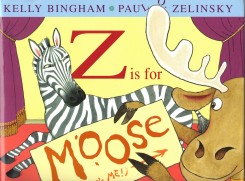
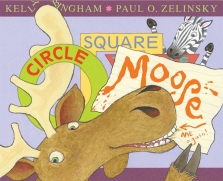

Kelly is donating one picture book critique, to be used at any time within the next 12 months.
This prize will be given away at the conclusion of PiBoIdMo. You are eligible for this prize if:
- You have registered for PiBoIdMo.
- You have commented ONCE ONLY on today’s post.
- You have completed the PiBoIdMo challenge. (You will have to sign the PiBoIdMo Pledge at the end of the event.)
Good luck, everyone!


 by Mira Reisberg
by Mira Reisberg
Reclaiming:
Your sister/mother/father/cousin is the artist. Your drawing is terrible. You’re hopeless at art. These are the things that you may have heard. Especially when you were a child. Voices that you’ve carried along allowing an important part of you to be silenced.
In some ways, as children’s book creative, our jobs are about accessing that child-like place of curiosity, wonder, and joy. That part that can spend solid time squatting in dirt watching a worm wiggle around in the earth and then reach out and touch it.
Making art is a bit like that. Mucking around in sometimes yucky materials, seeing what will happen if you add a touch of ochre to that blue with some titan buff instead of titanium white. Suddenly your sea is more sea like. Suddenly the endorphins are flowing and you’re in that place of child-like wonder wandering around in the right side of your brain where emotion and intuition hang out. After a while you consciously or unconsciously remember these experiments and how when you do this that happens and the colors, patterns, shapes, compositions you like, become ingrained as habit and begin to develop into your personal visual vocabulary or style. In many ways, it’s like driving a car. Alien at first then effortless after a while. If you do this, that happens. But unlike driving a car, artists are always evolving, trying new moves, new materials, new styles and new combinations. Playing in the dirt.
Playful illustrators whose style epitomizes that child-like delight with a more child-like style include the Diary of a Wimpy Kid books by Jeff Kinney, Naked and I’m Bored by Debbie Ohi, Mo Willem’s Pigeon books, Lauren Child’s books, and Todd Parr and Lucy Cousins wildly successful work that kids often look at and go “I could do that!”



These days, like never before, publishers want author/illustrators. These days publishers are also embracing artwork that may not be technically perfect but whose spirit and originality is totally, playfully, perfect!
Revitalizing:
While realism will always be greatly valued in the exquisite works of artists like John Muth, David Weisner, Julie Downing, E.B. Lewis and many others, there is a new embrace and desire for wild, spontaneous, fresh looking art that mixes it up. Try combining different materials with collage, try standing up and using your whole body to draw with freedom, or try creating loose ink or charcoal drawings like Chris Raschka does. Try playing with new materials that you’ve never used before so that you are more willing to be a child learning new things without judgment, experimenting in the dirt. Watch that worm wriggle. Then gently reach out and touch it.
Years ago Pablo Picasso said, “Every child is an artist. The problem is how to remain an artist once we grow up.” In the 1960’s Buckminster Fuller wrote, “Everyone is born a genius, but the process of living de-genius’s them.” Who’s ready to reclaim or revitalize their inner artist, childlike joy and visual genius? Take a walk on the wild side.

Mira Reisberg is the Director and founding instructor of the Children’s Book Academy. She has been involved in the children’s book industry since early 1988 as an illustrator, writer, editor, and art director as well as working as a kid lit university professor. Over the years she has taught many now successful children’s book writers and illustrators.
Starting November 3rd, Mira will be co-teaching the Craft and Business of Illustrating Children’s Books with Chronicle Books’ Design Director and Art Director extraordinaire for fearful beginning artists, multi-published illustrators, and adventurous writers. Find out more here.


 by Kristi Valiant
by Kristi Valiant
Are you ready to jump in? Do you have a few picture book ideas you’ve been keeping secret so you can write them down today and count them? Now for some more…
Start an ongoing list of things you adore or loathe or laughed out loud at or evoked some kind of emotion that stuck with you. Is there a tradition or memory from childhood that comes to mind? What about that time your friend got in trouble for something silly? Write down that funny thing your grandchild or pet did that you keep telling everyone about. It could even be a ridiculous incident your cousin’s yoga instructor mentioned in a Facebook post that you’re still laughing about.
For example, my adorable 2-year-old girl in pigtails walked up to some older kids on the playground and growled in their faces so they’d move and she could play on the slide by herself. I then explained to her that we don’t growl at people. We aren’t bears or monsters. I wrote that down as a picture book idea. But it’s not really a whole picture book, and having Mommy step in to fix the problem is a big no-no in picture books. I can use that real-life experience as a starting point for a character whose personality doesn’t match her appearance, and then make it a better story.
Don’t be afraid to change the way something happened. Writing fiction is lying in a good way. Sometimes we get so stuck on basing our manuscript on a real-life experience or a sweet person or animal we love, that we’re preventing our manuscript from becoming a fully realized, great book.
I illustrated a picture book written by Danielle Steel that just came out this week called PRETTY MINNIE IN PARIS. (Cue the celebratory chocolate lava cake!) This book is based on Danielle’s own teacup-size Chihuahua named Minnie. Did Danielle write Minnie true-to-life? Nope!

In the book, Minnie loves being out and about in Paris, but Danielle’s real pet Minnie is squeamish about touching sidewalks or even being set down outside. In the book, Minnie is a fashionable pup with an outfit for every occasion, but when I visited Danielle and the real Minnie in Paris last year, Danielle had a blast dressing Minnie up for me, but Minnie was mortified! She is not a fan of doggie clothes. Minnie has even rolled on her back and refused to get up when Danielle dressed her in a snowsuit before. That one tidbit made it into the book, but the rest of the book is mostly made up.
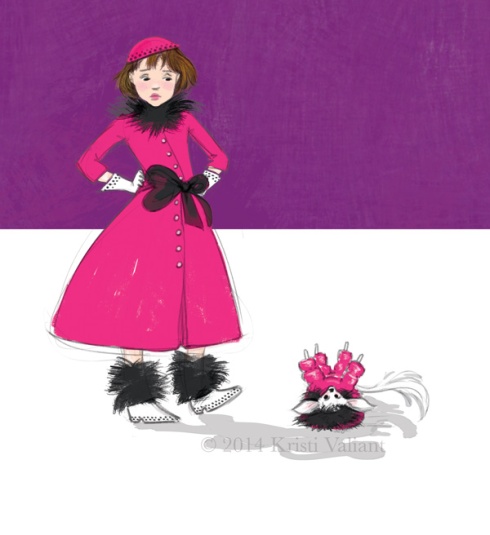
If you’re basing a story on real people or animals in your life, you may have a tendency to try to protect them in your story or to make them too perfect. I have a sketch dummy ready to submit that’s based on my husband and daughters and a chasing game we play. I have to admit it was a bit hard to make my little girl shed tears in that story. I had to keep telling myself it’s not really her. Don’t go easy on your characters. They aren’t your real kids or pets.

To sum it up, be inspired by real-life incidents, people, and animals, but then ask, “What would make this an even better story?” That’s where the fun starts.
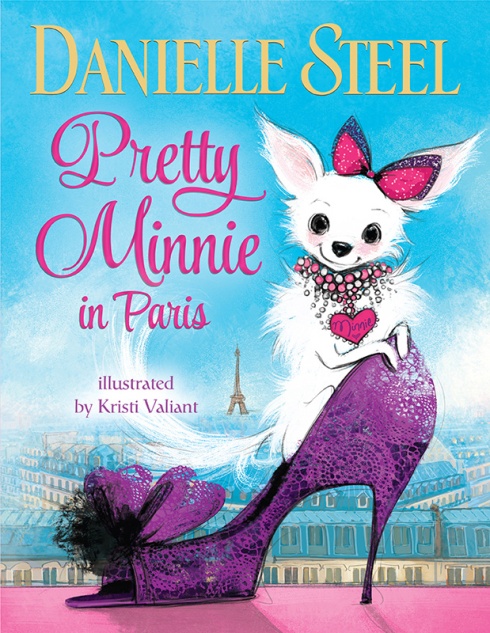

Kristi wrote and illustrated the picture book PENGUIN CHA-CHA and illustrated Danielle Steel’s picture book, PRETTY MINNIE IN PARIS, as well as the Little Wings chapter book series, THE GOODBYE CANCER GARDEN, CORA COOKS PANCIT, and others. Her books received a Starred Review from School Library Journal and won some shiny awards. Kristi graduated magna cum laude from Columbus College of Art & Design with a major in Illustration. She grew up in Wisconsin, studied in Ohio, danced in Texas, taught in China, and now lives in Indiana with her husband, daughters, and a room full of hippos, monkeys and sneaky penguins.
Visit Kristi online at KristiValiant.com or on Facebook at http://www.facebook.com/kvaliant.
PRETTY MINNIE IN PARIS has its own website (http://www.randomhousekids.com/brand/pretty-minnie) with a look inside the book, Minnie’s map of Paris, and a paper dog activity in which you can print out Minnie and dress her up in lovely outfits. Oh la la!

Kristi Valiant will sign a copy of PRETTY MINNIE IN PARIS for a lucky winner!
This prize will be given away at the conclusion of PiBoIdMo. You are eligible for this prize if:
- You have registered for PiBoIdMo.
- You have commented ONCE ONLY on today’s post.
- You have completed the PiBoIdMo challenge. (You will have to sign the PiBoIdMo Pledge at the end of the event.)
Good luck, everyone!



By:
Tara Lazar,
on 10/31/2014
Blog:
Tara Lazar
(
Login to Add to MyJacketFlap)
JacketFlap tags:
Fancy Nancy,
Dianne de Las Casas,
Cloudy with a Chance of Meatballs,
Alexander and the Terrible Horrible No Good Very Bad Day,
NINJA!,
PiBoIdMo 2014,
Crankenstein,
Uncategorized,
Picture Books,
Book Titles,
Add a tag
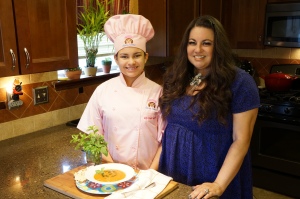 by Dianne de Las Casas
by Dianne de Las Casas
I am the founder of Picture Book Month and it starts tomorrow, November 1. The website, PictureBookMonth.com, features essays from thought leaders in the children’s literature community. Each day in November, a new essay is posted. This year’s Picture Book Month Champions are: Chris Barton, Aaron Becker, Kelly Bingham , Sophie Blackall, Arree Chung, Anna Dewdney, Johnette Downing, Ame Dyckman, Jill Esbaum, Carolyn Flores, Lupe Ruiz-Flores, Robin Preiss Glasser, Deborah Heiligman, Marla Frazee, Stefan Jolet, Kathleen Krull, Rene Colato Lainez, Loreen Leedy, Betsy Lewin, Ted Lewin, Brian Lies, Kelly J. Light, Debbie Ridpath Ohi, Alexis O’Neill, Sandra Markle, Ann Whitford Paul, Aaron Reynolds, Judy Schachner, Linda Joy Singleton, and David Schwartz. Please join the celebration!

As you prepare for PiBoIdMo, think about the titles of your picture books. In a recent interview for California Kids! magazine, Patricia Newman asked me, “How do you come up with titles for your books?” This started me thinking in depth about picture book titles. What’s in a title? How important is a title to a book? Can a book be centered around its title?
As it turns out, titles are vital to a book’s success. Author Scott Westerfield says, “Titles name a book, and names are important. A good name can make or break you.”
Brandi Reissenweber of Gotham Writers “Ask the Writer” column says, “A title is a story’s first impression. People make a first impression with appearance, wardrobe, and body language. Stories do it with a title.”
Eric Ode says, “Dan, the Taxi Man began as nothing more than a title. And one of the books I have coming out next year began as a title.”
PiBoIdMo founder and picture book author Tara Lazar says, “Most of my books begin as titles. It’s just the way my mind works. I want a BAM! concept, something that really hits you, and I find that people get HIT best with a succinct, powerful title.”
Corey Rosen Schwartz says, “I have written several books around titles! Like Tara [Lazar], most of my books begin that way. Goldi Rocks and the Three Bears, for example, was just a title on my PiBoIdMo 2009 list.”
Character-Based Titles
Many picture books have character-driven titles. The character of the book IS the title. Do you have a book character that is so compelling that the character’s name should be the book’s title? Here are some examples:
- Olivia by Ian Falconer
- Splat the Cat by Rob Scotton
- Flat Stanley by Jeff Brown
- Amelia Bedelia by Peggy Parish
- Biscuit by Alyssa Satin Capucilli
- Fancy Nancy by Jane O’Connor
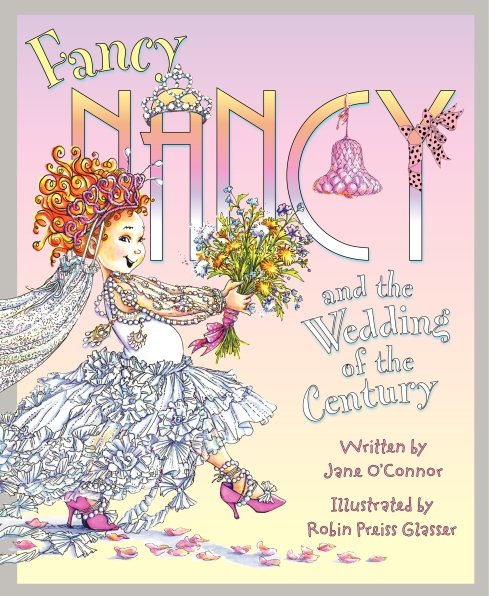
Clever, Punny Titles
I am a big fan of clever, punny titles. In fact, several of my books have punny titles. Here are some examples that are just too clever for words… almost.
- Crankenstein by Samantha Berger
- The Monstore by Tara Lazar
- Little Red Hot by Eric Kimmel
- Pinkalicious by Victoria Kann
- Epossumondas by Colleen Salley
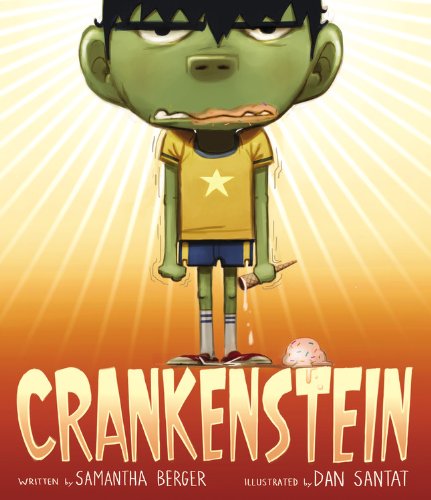
Verbose Titles
I am generally a fan of the “less is more” title for a book but sometimes, a garrulous title is EXACTLY what the book calls for. Can you imagine these books with a short title?
- Alexander and the Terrible, Horrible, No Good, Very Bad Day by Judith Viorst
- Don’t Let the Pigeon Drive the Bus by Mo Willems
- How Do Dinosaurs Say I Love You? by Jane Yolen
- There Was an Old Lady Who Swallowed a Fly by Simms Taback (a folktale retelling)
- The Fantastic Flying Books of Morris Lessmore by William Joyce
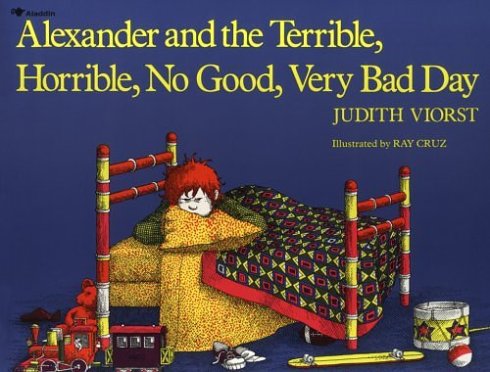
Plot-Based Titles
Some titles beckon you to open the book. These titles are based around the book’s plot. Yes, as short as a picture book is, it can still have a plot. In fact, these picture book plots were so inspiring that they were turned into Hollywood blockbuster movies!
- Cloudy with a Chance of Meatballs by Judi Barrett
- A Night at the Museum by Milan Trenc
- The Story of Ferdinand by Munro Leaf
- We’re Back! A Dinosaur’s Story by Hudson Talbott
- Where the Wild Things Are by Maurice Sendak
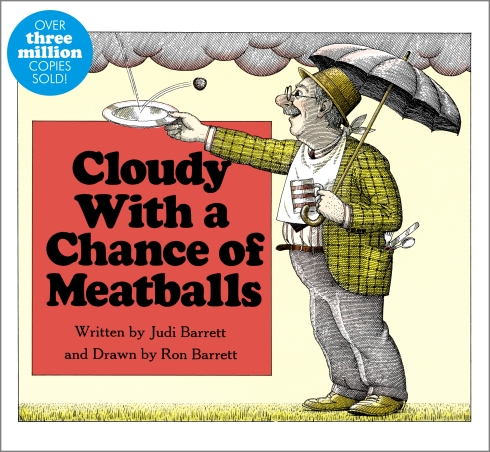
Single-Word Titles
A picture book title can also be short and succinct, even one-word. These acclaimed picture books prove that a word is worth a thousand pictures.
- Green by Laura Vaccaro Seeger
- Blackout by John Rocco
- Ninja! by Arree Chung
- Carnivores by Aaron Reynolds
- Hug by Jez Alborough
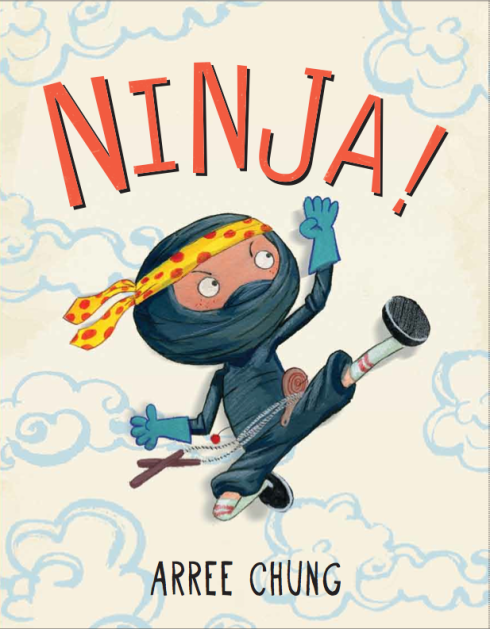
Aaron Zenz says, “Hiccupotamus started with the title. I really wouldn’t have had any desire to write a book about a bunch of jungle animals chasing around a disruptive hippo if not for the title. In my mind, the pun ‘Hiccupotamus’ is the most important thing about that particular book.”
As you create and engage your imagination this month, think about your picture book’s title. In what way can an engaging title enhance your picture book? How can you use the title to attract readers? Perhaps you can be the Author with the Terrific, Tremendous, Oh-So-Grand, Very Remarkable Title.
As you celebrate PiBoIdMo and Picture Book Month, read LOTS of picture books. Comment below and share with us your favorite picture book titles and why you think they are so splendiferous. Here’s to Picture Books! Read * Share * Celebrate!

Dianne de Las Casas is an award-winning author, storyteller, and founder of Picture Book Month. Her performances, dubbed “revved-up storytelling” are full of energetic audience participation. The author of 24 books, Dianne is the International Reading Association LEADER 2014 Poet Laureate, and the 2014 recipient of the Ann Martin Book Mark award. Her children’s titles include The Cajun Cornbread Boy, There’s a Dragon in the Library, The Little “Read” Hen, The House That Santa Built, and Cinderellaphant. Visit her website at diannedelascasas.com. Visit Picture Book Month at PictureBookMonth.com. Twitter & Instagram: @AuthorDianneDLC Picture Book Month Twitter: @PictureBkMonth Facebook: fanofdianne and PictureBookMonth. Dianne is the proud mom of 14-year-old culinary celebrity, Kid Chef Eliana.


 by Molly O’Neill
by Molly O’Neill
It’s day [whatever] of PiBoIdMo when it finally happens . . . you run out of ideas.
The blank page. It mocks you. And you’re panicked, because you’ve already plundered every cute/amusing thing your kids/pets have ever done, looking for inspiration. You’ve already turned your own experiences into rollicking, rhythmic (but never rhyming!) texts. You’ve perhaps even transformed Buzzfeed videos about unexpected animal friendships into whimsical odes to human emotions.

So now what? Well, now comes inspiration in the form of one of my favorite quotations:
“The real voyage of discovery consists not in seeking new landscapes, but in having new eyes.” —Marcel Proust
Even though this quote is nearly 100 years old, it’s meaningful, especially for a writer. In fact, Proust probably made this observation because as an author himself, he knew well that reaching past one’s initial, obvious, or cliched ideas to a place of true, fresh, personal creativity is among a writer’s greatest challenges—and greatest triumphs, when achieved. So, in Proust’s spirit, here are 5 tips to train your eyes, make new discoveries, and ultimately shape your words as a writer.
- Warm up your vision. Take one of your favorite ideas from a previous day’s writing and spin it into something fresh and new by changing one key element—like the point of view, the setting, or even a character’s identity. Switch the narrative voice from first person to third person, or turn from a contemporary setting to one that’s exotic or faraway or historical or fantastical. You can even turn human characters into animals and vice versa, or swap who the reader will see as the story’s hero/villain. And since the shape of your story was already established in your earlier creation (whether it was a full manuscript or just a simple outline), you’re temporarily free from thinking about plot and can instead play with transformation-enhancing details of voice and language. You may even realize that you enjoy the resulting version of the story more than your original! (An aside—one of my favorite books on writing covers similar ground: exploring how shifts in perspective can spark your creativity: check out 99 Ways to Tell a Story by Matt Madden.)
- Train your new eyes in real life. For one week, outlaw yourself from taking even a single photo. Every time you reach for your phone or other device to take a photo, force yourself instead to capture the moment differently, using only words! At the end of the week, select your favorite of these moments-turned-into-words on Facebook or Instagram and ask your friends and family if they can “see” the moment through your words alone. (If you like, snap a photo of your screen or notepad for more effective/visual social sharing.)

- Watch for details that make you ask “why.” Stories don’t always arrive in your mind, fully-imagined. Often, they start with a simple-but-intriguing image or detail, and the author’s curiosity to explore the story behind it. So study everyday life for places where paradoxes happen and tensions meet—for moments are memorable and yet unexpected at the same time. If you’re writing a humorous story, these details can sometimes add a layer of ridiculousness or absurdity that picture book readers will delight in. But more importantly, they make readers ask “why” enough to keep on turning pages. For example, imagine: Best friends who are suddenly not speaking, and no one knows why. A castle with a doorway that’s too small for any of its inhabitants to walk through. An abandoned home with a gift-wrapped package waiting at the door. With any of these jumping-off points or thousands of others like them, you can often reveal an interesting story to yourself (and your future readers) if you ask enough whys or what-ifs.
- Reverse the story-making process with visual storytelling. Many writers are accustomed to thinking that text always precedes art. But exercises in visual storytelling can engage your creativity in entirely different ways—making art an integral part of your creative process. To try this type of hybrid creativity, explore Storybird, which houses a curated collection of high-quality, original art and offers free and simple creative tools for authors. Simply select an image that catches your eye, and then use the art to enable your writing in one of countless ways—it can help spark or inspires story ideas; help you “unlock” or puzzle your way through a story, offering visual clues and perspective to offset your own imagination and talent with words; or simply enhance a story you’ve already been imagining. You can keep a story private, and share the link only with those you choose (like critique partners or friends/family); or you can add your stories into Storybird’s public library to get swift feedback from millions of young readers worldwide who use the platform.

- Remember that less is more. In art or photography, “negative space” is the white space in and around an image’s subject that helps viewers focus. For writers, there is sometimes a temptation to think that more words = better. But just like negative space can enhance artwork, sometimes a few well chosen words will say far more than an endless ramble. Fewer words means that each carries more power, so their precise selection and arrangement matters more. Similarly, remember that what’s not on the page is just as important as what is, and if a detail of your story can be portrayed through artwork, then it rarely needs to be repeated in the text. Your job as an author is to decide what does not belong in a story, as much as what does!
Here’s hoping you arrive at the end of these exercises—and PiBoIdMo—with powerful new eyes that would make Proust proud. Questions? Thoughts? Please share them, and your own suggestions to fellow writers seeking creative vision and unique perspectives, in the comments.

Molly O’Neill is Head of Editorial at Storybird where she works at the intersection of story, art, technology, and new publishing opportunities for authors and artists. Previously she was an editor at HarperCollins, where she launched the careers of talented authors and illustrators including bestselling phenom Veronica Roth (author of Divergent), heartwarming award-winner Bobbie Pyron (author of A Dog’s Way Home), and the distinctive narrative and visual voices of S. J. Kincaid (author of Insignia), Hilary T. Smith (author of Wild Awake), Sarah Jane Wright (illustrator of A Christmas Goodnight), and many others. Follow Storybird on Twitter for daily thoughts on art, writing, and creativity.


View Next 25 Posts






 by
by 






































 Henry Herz has masters degrees in engineering and political science, neither of which help him write children’s books. He enjoys moderating sci-fi/fantasy literature panels at conventions, eating Boston Creme Pie, and writing children’s books with his sons Josh and Harrison. Their indie-published Nimpentoad was featured in Young Entrepreneur, Wired GeekDad, and CNN. Their picture book, Monster Goose Nursery Rhymes, will be published by Pelican in January 2015. Henry edited the YA dark fantasy anthology, Beyond the Pale, with stories from Peter S. Beagle, Heather Brewer, Jim Butcher, Rachel Caine, Kami Garcia, Nancy Holder, Jane Yolen and others. He interviews KidLit authors and illustrators at
Henry Herz has masters degrees in engineering and political science, neither of which help him write children’s books. He enjoys moderating sci-fi/fantasy literature panels at conventions, eating Boston Creme Pie, and writing children’s books with his sons Josh and Harrison. Their indie-published Nimpentoad was featured in Young Entrepreneur, Wired GeekDad, and CNN. Their picture book, Monster Goose Nursery Rhymes, will be published by Pelican in January 2015. Henry edited the YA dark fantasy anthology, Beyond the Pale, with stories from Peter S. Beagle, Heather Brewer, Jim Butcher, Rachel Caine, Kami Garcia, Nancy Holder, Jane Yolen and others. He interviews KidLit authors and illustrators at  by Kelly Light
by Kelly Light
 by
by 

 by
by 








 by
by 

 by
by 









 by
by 

 by
by 


 by
by 




 by
by 







 by
by 




 by
by 



 y
y 





 by
by 

 by
by 



 by
by 

 by
by 


 by
by 



 by
by 





 by
by 


Thanks for letting us peek into your two entirely different processes.
Whenever I have gotten to the end of anything I write and sigh, “oh, that just flowed so easily…” I know it is time to slog back through the blog and REALLY pick it apart…most times, I can find more than one thing that can make it better the second, third or 50th time around. Thanks for showing a ghost has a chance!!
Great insights! Once an author is successfully published, we like to think the writing process might be easier. You encourage each of us to keep writing. Thank you.
I loved this post! Thanks for the inspiration!
I love your description of the ease of completing one manuscript versus the challenge of another. Thanks.
Very interesting! Thank you!
So you’ve had a quick one and a tough one. If Goldilocks knows anything about anything, the next one should be just right. Turkey in the House? Bunny in the House? Cupid in the House? Congratulations and good luck. #notjealous #reallyjealous
Thanks for the honesty of this post. It’s nice to hear that some books are more a labor-of-love than instant inspiration, even for published authors. Can’t wait to read Elf in the House!
Sometimes the most magical of things are needy . . . but oh so worth it!
It”s the ying and yang of writing children’s books and you have experience both sides. Thanks for the article….
Deliberate, determined effort leads to delight. I love a happy ending. Thank you!
Thanks for this. Ideas can be given,inspired or painstakingly created. Need to hang in there and simply begin.
Just goes to show that picture books are not as easy as they look.
My daughter, who writes middle grade novels, wrote her first pb last week and commented that it took her longer to write less than 500 words than it did to write 2000 words for her novels. Keeping it short and simple isn’t as simple as it seems.
I loved hearing your two very different journeys for each book. Thank you for sharing, Ammi-Joan!